Hottinger Bruel and Kjaer T40C1 T40-C1 Torquemeter User Manual users manual
Hottinger Baldwin Messtechnik GmbH T40-C1 Torquemeter users manual
users manual
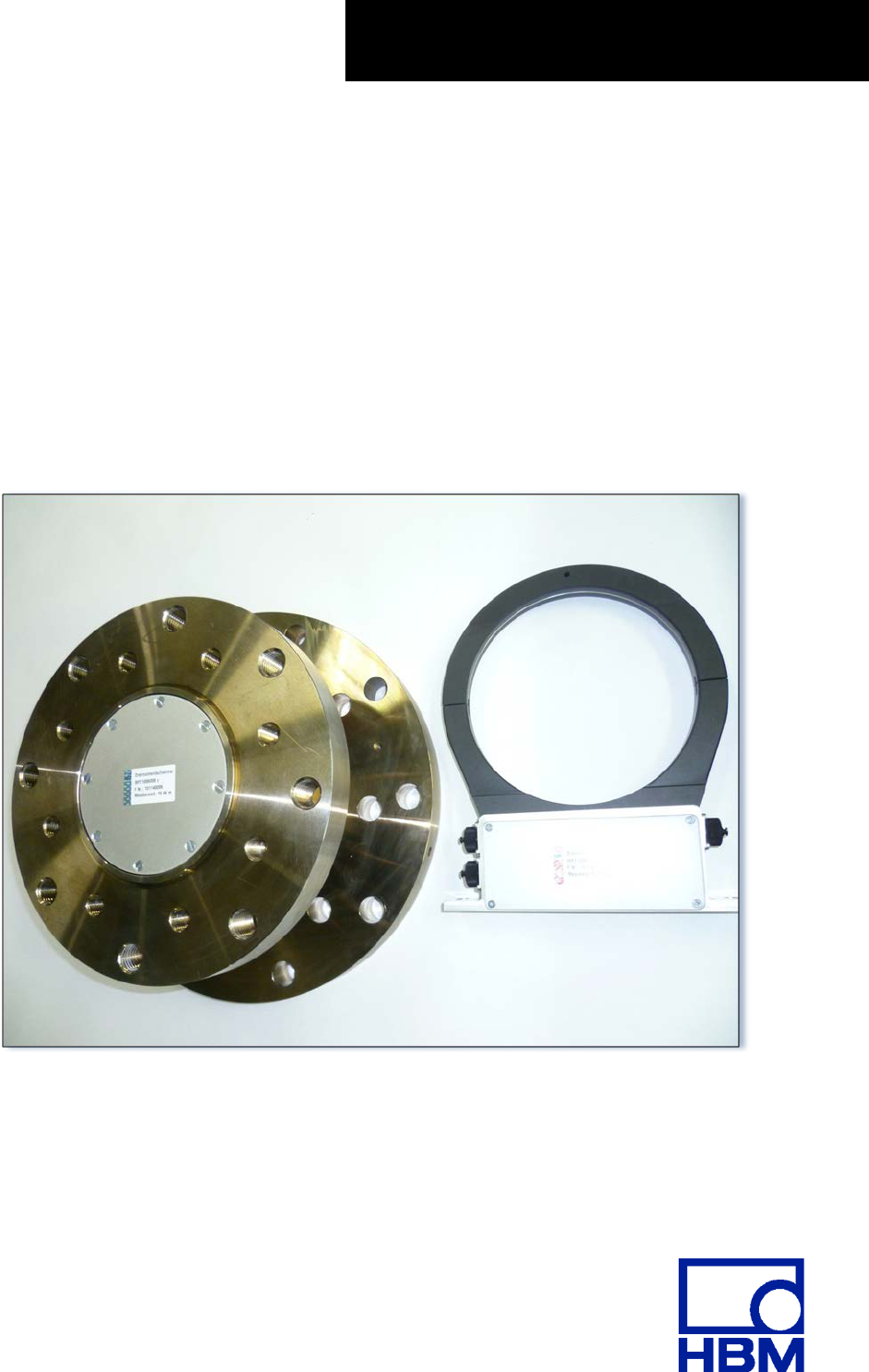
Mounting instructions
Torque flange
T40C1 (MPZ1006008 / MPZ1006009)
Version b 13.01.2015 HBM: public
Table of contents
1 Safety instructions ........................................................................................ 1
2 Markings used .............................................................................................. 7
2.1
Symbols
on the
transducer
............................................................................................................... 7
2.2
The markings used in this document
............................................................................................ 7
3
Application
.................................................................................................. 8
4 Structure and mode of operation .................................................................. 9
5
Mechanical installation
............................................................................. 11
5.1 Important
precautions
during
installation
..................................................................................... 11
5.2
Conditions
on
site
............................................................................................................................. 12
5.3
Mounting position
.............................................................................................................................. 12
5.4
Installation options
........................................................................................................................... 12
5.4.1 Installation without dismantling the antenna ring ................................................................................ 13
5.4.2 Installation with
subsequent
stator
mounting
................................................................................... 14
5.5 Mounting the rotor ............................................................................................................................... 15
5.6 Mounting the
stator
............................................................................................................................ 17
5.7
Speed measuring system (optional)
............................................................................................ 21
6
Electrical connection
............................................................................... 23
6.1
General instructions
......................................................................................................................... 23
6.2 EMC
protection
.................................................................................................................................. 23
6.3
Connector pin assignment
............................................................................................................. 25
6.4 S
upply voltage
................................................................................................................................... 27
7
Shunt signal
............................................................................................. 28
8 Functionality testing ................................................................................... 29
8.1
Rotor status,
LED A (upper LED) ................................................................................................... 29
Version b 13.01.2015 HBM: public
8.2
Stator status, LED B (lower LED)
............................................................................................... 30
9
Loading capacity
...................................................................................... 31
10 M
aintenance
........................................................................................... 32
11
Waste disposal
and
environmental protection
...................................... 32
12
Dimensions
............................................................................................. 33
12.1
Torque flange - 15kN·m
................................................................................................................. 33
12.2 Torque flange - 25kN·m .................................................................................................................... 33
13
Order numbers, accessories
.................................................................. 35
14
Specifications
.......................................................................................... 36
15 Supplementary technical information ........................................................ 40
Version b 13.01.2015 HBM: public
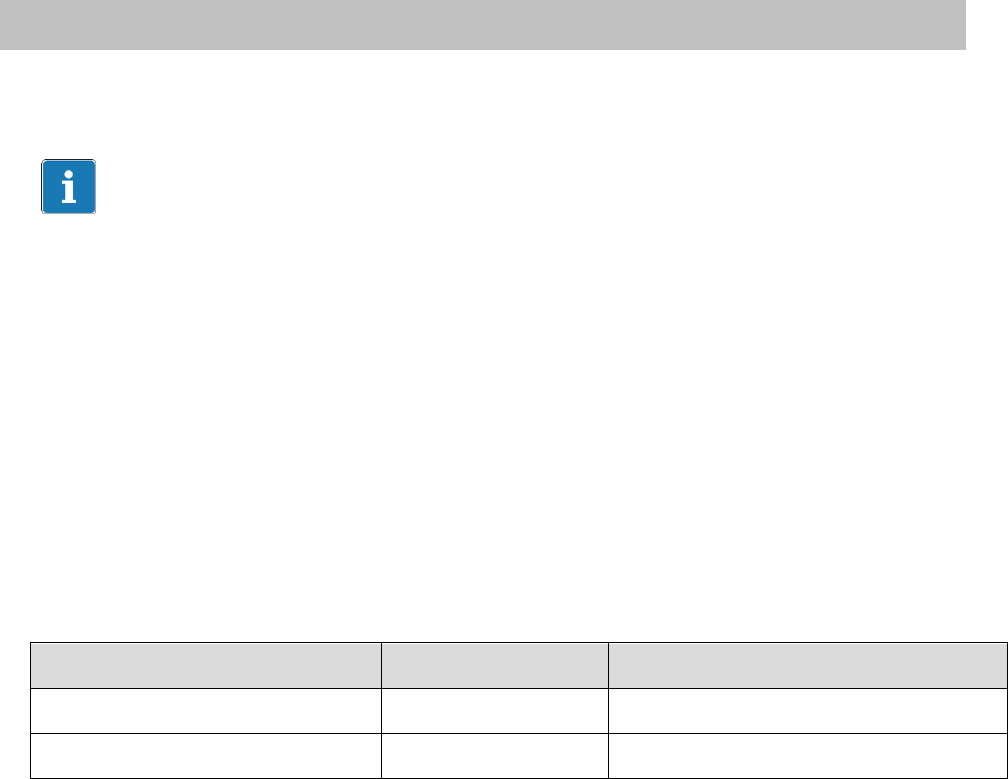
1
1 Safety instructions
FCC Compliance & Advisory Statement for Option 7, Code U
Important
Any changes or modification not expressly approved in writing by the party responsible for
compliance could void the user’s authority to operate the device. Where specified additional
components or accessories elsewhere defined to be used with the installation of the product,
they must be used in order to ensure compliance with FCC regulations.
This device complies with Part 15 of the FCC Rules. Operation is subject to the following two
conditions: (1) this device may not cause harmful interference, and (2) this device must
accept any interference received, including interference that may cause undesired operation.
The FCC identifier or the unique identifier, as appropriate, must be displayed on the device.
Model
Measuring range
FCC ID
T40C1 - MPZ1006008 15 kN·m
2ADAT-T40C1
T40C1 - MPZ1006009 25 kN·m
2ADAT-T40C1
Version b 13.01.2015 HBM: public
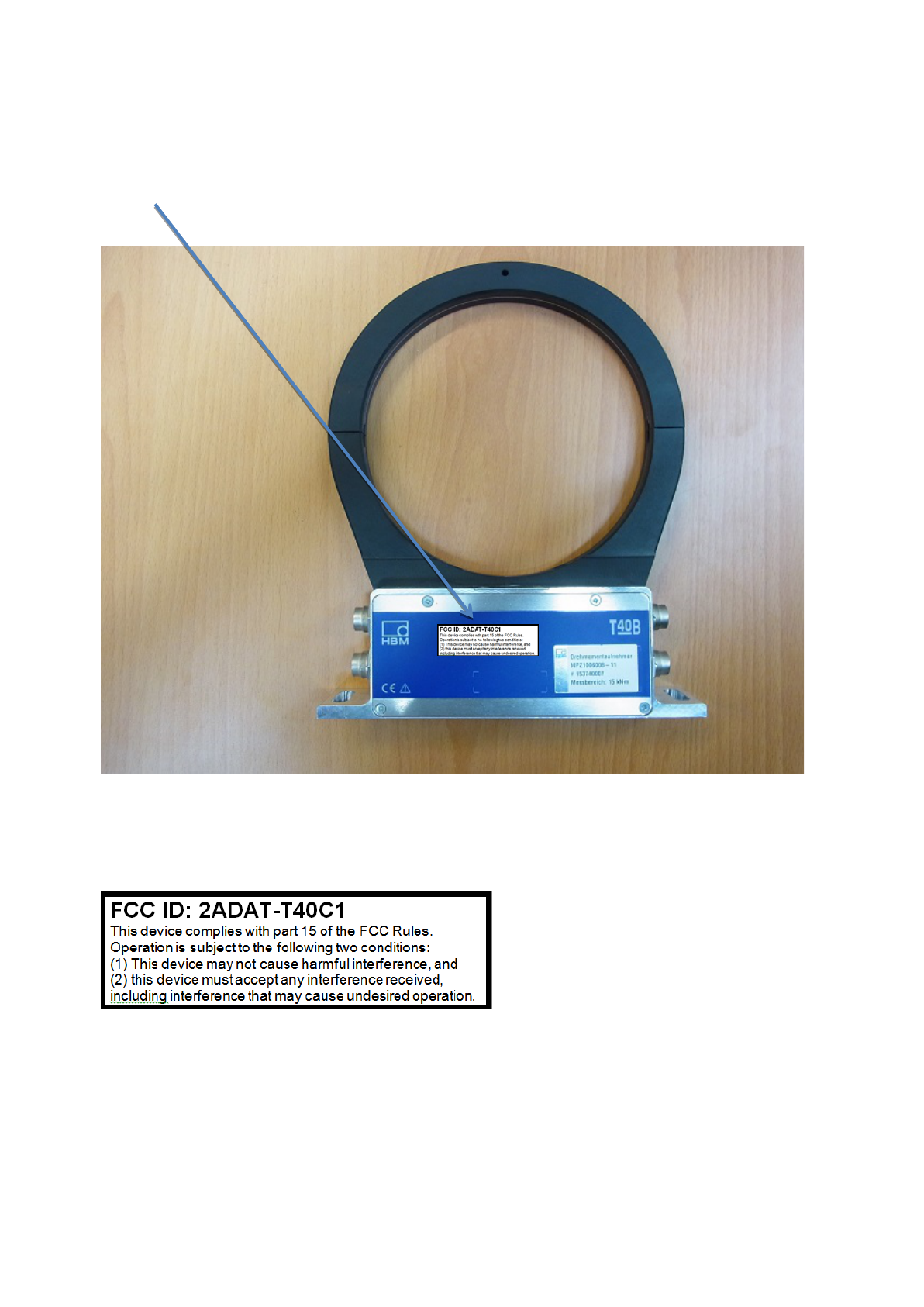
2
Label example with FCC ID and IC number
FCC ID: 2ADAT-T40C1
Position
Fig. 1.1 Location of the label on the stator of the device
Fig. 1.2 Example of the label
Version b 13.01.2015 HBM: public

3
Industry Canada for Option 7, Code U
Darmstadt, 2014-11-13
This product has not yet received IC (Industry Canada) approval. The certification process for
this product is still under way. HBM currently expects that IC approval will
be granted by the end of December 2014.
Your local HBM contact looks forward to answer any questions you may have regarding IC
approval.
Darmstadt, le 13 novembre 2014
Ce produit n'a pas encore obtenu l'approbation IC (Industrie Canada). Le produit est encore
en processus de certification. Actuellement, HBM suppose que l'approbation
IC sera accordee jusqu'a fin decembre 2014. Si vous avez des questions au sujet de
l'approbation IC, veuillez vous adresser a votre representation HBM sur place.
This device complies with Industry Canada standard RSS210.
This device complies with Industry Canada license−exempt RSS standard(s).Operation is
subject to the following two conditions: (1) this device may not cause interference, and (2) this
device must accept any interference, including interference that may cause undesired
operation of the device.
Cet appareil est conforme aux norme RSS210 d’Industrie Canada.
Cet appareil est conforme aux normes d’exemption de licence RSS d’Industry Canada. Son
fonctionnement est soumis aux deux conditions suivantes : (1)cet appareil ne doit pas causer
d’interference et (2) cet appareil doit accepter toute interference, notamment les interferences
qui peuvent affecter son fonctionnement.
Version b 13.01.2015 HBM: public
4
Intended u
se
The torque flange is used exclusively for torque, angle of rotation and power measurement
tasks within the load limits stipulated in the specifications. Any other use is not the
designated use.
Stator operation is only permitted when the rotor is installed.
The torque flange may only be installed by qualified personnel in compliance with the
specifications and with the safety requirements and regulations of these mounting
instructions. It is also essential to observe the applicable legal and safety regulations for the
application concerned. The same applies to the use of accessories.
The torque flange is not intended for use as a safety component. Please also refer to the
section "Additional safety precautions". Proper and safe operation requires proper
transportation, correct storage, siting and mounting, and careful operation.
Loading capacity limits
The data in the technical data sheets must be complied with when using the torque flange.
In particular, the respective maximum loads specified must never be exceeded. The
following limits set out in the specifications must not be exceeded, e.g.:
• Limit torque
• Longitudinal limit force, lateral limit force or bending limit moment
• Torque vibration bandwidth
• Breaking torque
• Temperature limits
• Limits of electrical loading capacity
Use as a
machine element
The torque flange can be used as a machine element. When used in this manner, it
must be noted that, to favor greater sensitivity, the transducer is not designed with the
safety factors usual in mechanical engineering. Please refer here to the section
"Loading capacity limits", and to the specifications.
Version b 13.01.2015 HBM: public
5
Accident prevention
According to the prevailing accident prevention regulations, once the transducers have
been mounted, a covering agent or cladding has to be fitted as follows:
• The covering agent or cladding must not be free to rotate.
• The covering agent or cladding should prevent squeezing or shearing and
provide protection against parts that might come loose.
• Covers and cladding must be positioned at a suitable distance or be so arranged
that there is no access to any moving parts within.
• Covering agents and cladding must still be attached even if the moving parts of the
torque flange are installed outside peoples' movement and working range.
The only permitted exceptions to the above requirements are if the torque flange is
already fully protected by the design of the machine or by existing safety precautions.
Additional safety precautions
The torque flange cannot (as a passive transducer) implement any (safety-relevant)
cutoffs. This requires additional components and constructive measures for which the
installer and operator of the plant is responsible. The layout of the electronics conditioning
the measurement signal should be such that measurement signal failure does not cause
damage.
The scope of supply and performance of the transducer covers only a small area of torque
measurement technology. In addition, equipment planners, installers and operators should
plan, implement and respond to safety engineering considerations in such a way as to
minimize residual dangers. Pertinent national and local regulations must be complied with.
General
dangers of
failing
to follow the safety instructions
The torque flange is state of the art and reliable. Transducers can give rise to residual
dangers if they are incorrectly operated or inappropriately mounted, installed and operated
by untrained personnel. Every person involved with siting, starting-up, operating or repairing
a torque flange must have read and understood the mounting instructions and in particular
the technical safety instructions. The transducers can be damaged or destroyed by non-
designated use of the transducer or by non-compliance with the mounting and operating
instructions, these safety instructions or any other applicable safety regulations (BG safety
and accident prevention regulations) when using the transducers. Transducers can break,
particularly in the case of overloading. The breakage of a transducer can also cause
damage to property or injury to persons in the vicinity of the transducer.
If the torque flange is not used according to the designated use, or if the safety instructions
or specifications in the mounting and operating instructions are ignored, it is also possible
that the transducer may fail or malfunction, with the result that persons or property may be
affected (due to the torques acting on or being monitored by the torque flange).
Conversions and modifications
The transducer must not be modified from the design or safety engineering point of
view except with our express agreement. Any modification shall exclude all liability on
our part for any damage resulting therefrom.
Selling on
If the torque flange is sold on, these mounting instructions must be included
Version b 13.01.2015 HBM: public
6
with the torque flange.
Qualified personnel
Qualified personnel means persons entrusted with siting, mounting, starting up and
operating the product, who possess the appropriate qualifications for their function.
This includes people who meet at least one of the three following requirements:
• Knowledge of the safety concepts of automation technology is a requirement and
as project personnel, you must be familiar with these concepts.
• As automation plant operating personnel, you have been instructed how to handle
the machinery. You are familiar with the operation of the equipment and
technologies described in this documentation.
• As commissioning engineers or service engineers, you have successfully completed
the training to qualify you to repair the automation systems. You are also authorized
to activate, ground and label circuits and equipment in accordance with safety
engineering standards.
Version b 13.01.2015 HBM: public
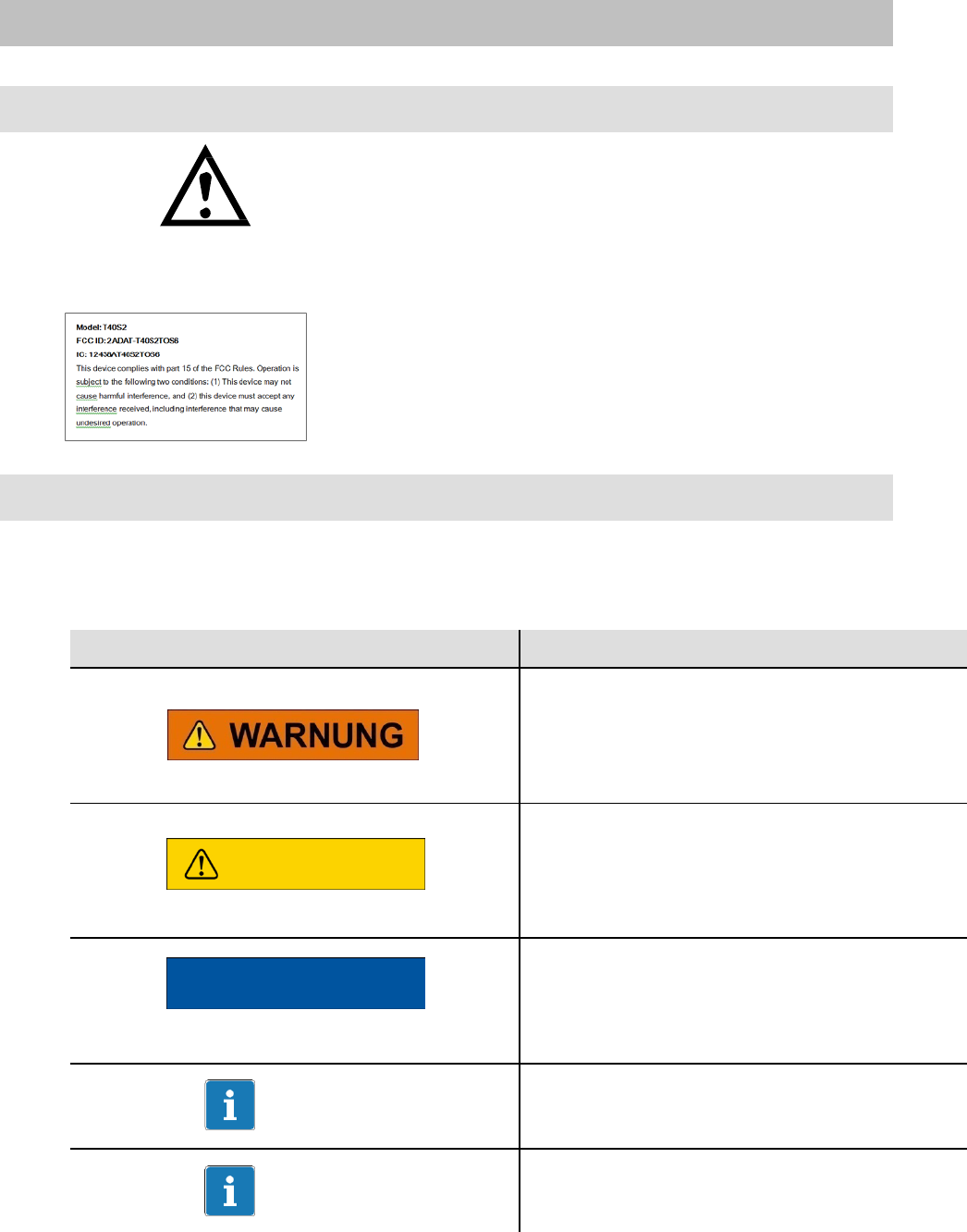
7
2 Markings used
2.1
Symbols
on the
transducer
Meaning: Read and note the
data
in
this
manual
Label example
Label example with FCC ID and IC number, Option 7 Code U.
Location of the label on the stator device.
2.2
The markings used in this document
Important instructions for your safety are specifically identified. It is essential to follow these
instructions in order to prevent accidents and damage to property.
Symbol
Meaning
This marking warns of a potentially
dangerous situation in which failure to
comply with safety requirements could
result in death or serious physical injury.
CAUTION
This marking warns of a potentially
dangerous situation in which failure to
comply with safety requirements can result
in slight or moderate physical injury.
NOTE
This marking draws your attention to a
situation in which failure
to
comply with
safety requirements could lead to
damage to property.
Important
This marking draws your attention to
information about the product or about
handling the product.
T
ip
This marking indicates application tips or
other information that is useful to you.
Version b 13.01.2015 HBM: public

8
Symbol
Meaning
This marking draws your attention to
information about the product or about
handling the product.
Emphasis
Italics are used to emphasize and highlight
texts.
3
Application
The torque flange measures static and dynamic torques on stationary and rotating shafts.
Test beds can be extremely compact because of the short construction of the transducer.
This offers a very wide range of applications.
The torque flange is reliably protected against electromagnetic interference. It has been
constructed according to the relevant European standards (e.g. EMC behavior) and/or
complies with US and Canadian standards. The product carries the FCC label.
This transducer is solely designed and may only be used for the following system types:
• MTU Marine test benches according to Request MPZ1006008 / MPZ1006009
Version b 13.01.2015 HBM: public
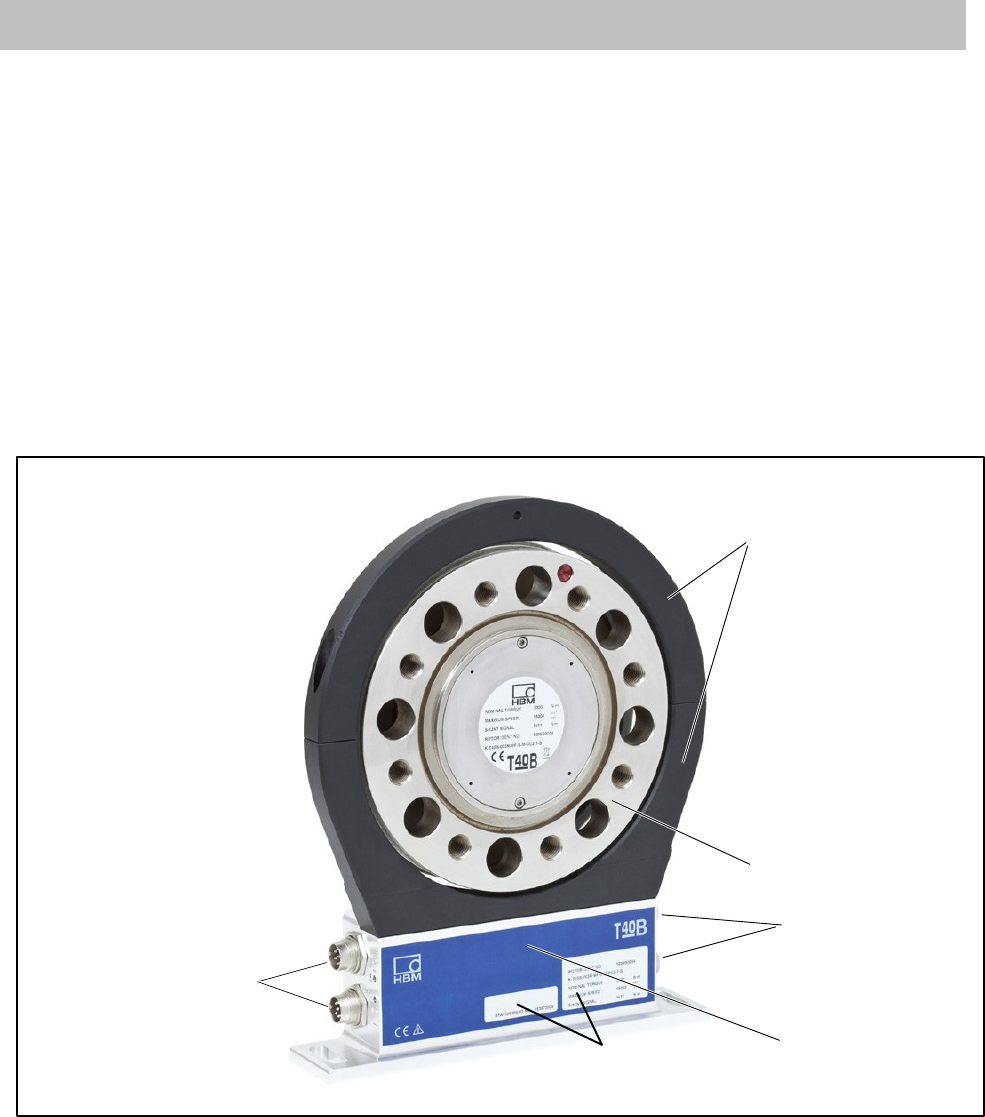
9
4 Structure and mode of operation
The torque flange consists of two separate parts: the rotor and the stator. The rotor
comprises the measuring body and the signal transmission elements.
Strain gauges (SGs) are installed on the measuring body. The rotor electronics for
transmitting the bridge excitation voltage and the measurement signal are located centrally
in the flange. The transmitter coils for contactless transmission of excitation voltage and
measurement signal are located on the measuring body's outer circumference. The signals
are sent and received by a separable antenna ring. The antenna ring is mounted on a
housing that includes the electronic system for voltage adaptation and signal conditioning.
Connectors for the torque and speed signals, the voltage supply and the digital output
are located on the stator. The antenna segments (ring) should be mounted more or less
concentrically around the rotor (see Chapter 5).
Antenna segments
Rotor
Connector plug
Connector plug
Identification plate Stator housing
Fig. 4.1: Possible mechanical construction without speed measuring system
The speed sensor can be optionally mounted on the stator. The speed is measured
magnetically with an AMR sensor and a magnetic ring. The magnetic ring for
measurement of speed is welded to the flange.
Version b 13.01.2015 HBM: public
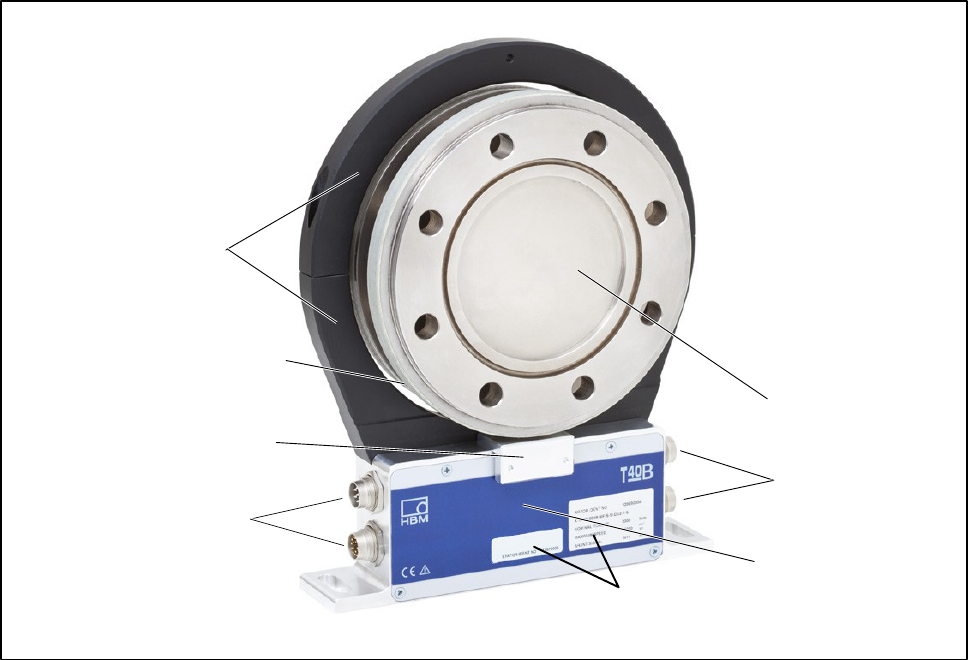
10
Antenna segments
Magnetic ring
for speed
measurement
Sensor head for
measuring speed
Connector plug
Rotor
Connector plug
Stator housing
Identification plate
Fig. 4.2: Mechanical construction with a speed measuring system
Version b 13.01.2015 HBM: public
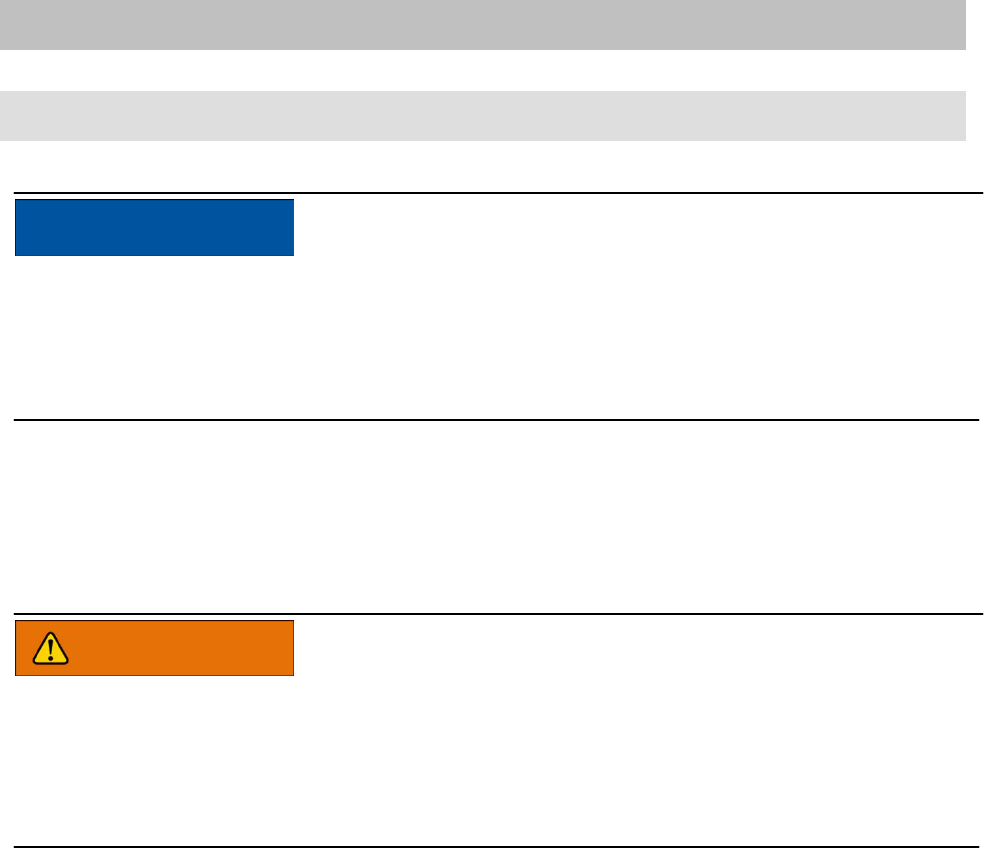
11
5
Mechanical installation
5.1 Important
precautions
during
installation
NOTE
A torque flange is a precision measurement element and therefore needs careful
handling. Dropping or knocking the transducer may cause permanent damage. Make
sure that the transducer cannot be overloaded, even while it is being mounted.
• Handle the transducer with care.
• Check the effect of bending moments, critical speeds and natural torsional
oscillations, to prevent the transducer being overloaded by increases in
resonance.
• Make sure that the transducer cannot be overloaded.
W
ARNING
There is a danger of the transducer breaking if it is overloaded. This can cause danger for
the
operating personnel
of the system in which the
transducer
is
installed
.
Implement appropriate safety measures to avoid overloads and to protect against resulting
dangers.
• Use a screw locking device (medium strength, e.g. LOCTITE No. 242) to glue the
screws into the counter thread to exclude pre-stressing loss due to screw
slackening, if alternating loads are to be expected.
• Comply with the mounting dimensions to enable correct operation.
An appropriate shaft flange enables the torque flange to be mounted directly. It is also
possible to mount a joint shaft or relevant compensating element directly on the rotor (using
an intermediate flange when required). Under no circumstances should the permissible
limits specified for bending moments, lateral and longitudinal forces be exceeded. Due to
the torque flange's high torsional stiffness, dynamic shaft train changes are kept to a
minimum.
Version b 13.01.2015 HBM: public

12
Important
Even if the unit is installed correctly, the zero point adjustment made at the factory can shift
by up to approx. 2% of the sensitivity. If this value is exceeded, we advise you to check the
mounting conditions. If the residual zero offset when the unit is removed is greater than 1%
of the sensitivity, please send the transducer back to the Darmstadt factory for testing.
5.2
Conditions
on
site
The torque flange must be protected against coarse dirt particles, dust, oil, solvents and
humidity.
There is wide ranging compensation for the effects of temperature on the output and zero
signals of the transducer (see Chapter "Specifications"). If there are no static temperature
ratios, for example, because of the temperature differences between the measuring body
and the flange, the values given in the specifications can be exceeded. In this case, ensure
static temperature ratios by cooling or heating, depending on the application. As an
alternative, check if thermal decoupling is possible, e.g. by means of heat radiating
elements such as multiple disc couplings.
5.3
Mounting position
The torque flange can be mounted in any position.
With clockwise torque, the output frequency is, depending on the option, 60 - 90 kHz, 10 -
15 kHz or 240 - 360 kHz). With HBM amplifiers or with the voltage output option, a positive
output signal (0 V -+10 V) is present. In the case of the speed measuring system, an arrow
must be attached to the stator housing to clearly define the direction of rotation: If the
measurement flange moves in the direction of the arrow, connected HBM measuring
amplifiers deliver a positive output signal.
5.4
Installation options
In principle, there are two possibilities for torque flange mounting: with the antenna ring
complete or dismantled. We recommend mounting as described in Chapter 5.4.1. If
mounting in accordance with Chapter 5.4.1 is not possible, (e.g. in the case of subsequent
stator replacement), you will have to dismantle the antenna ring. It is essential in this case
to comply with the notes on assembling the antenna segments (see Chapter 5.4.2).
Version b 13.01.2015 HBM: public
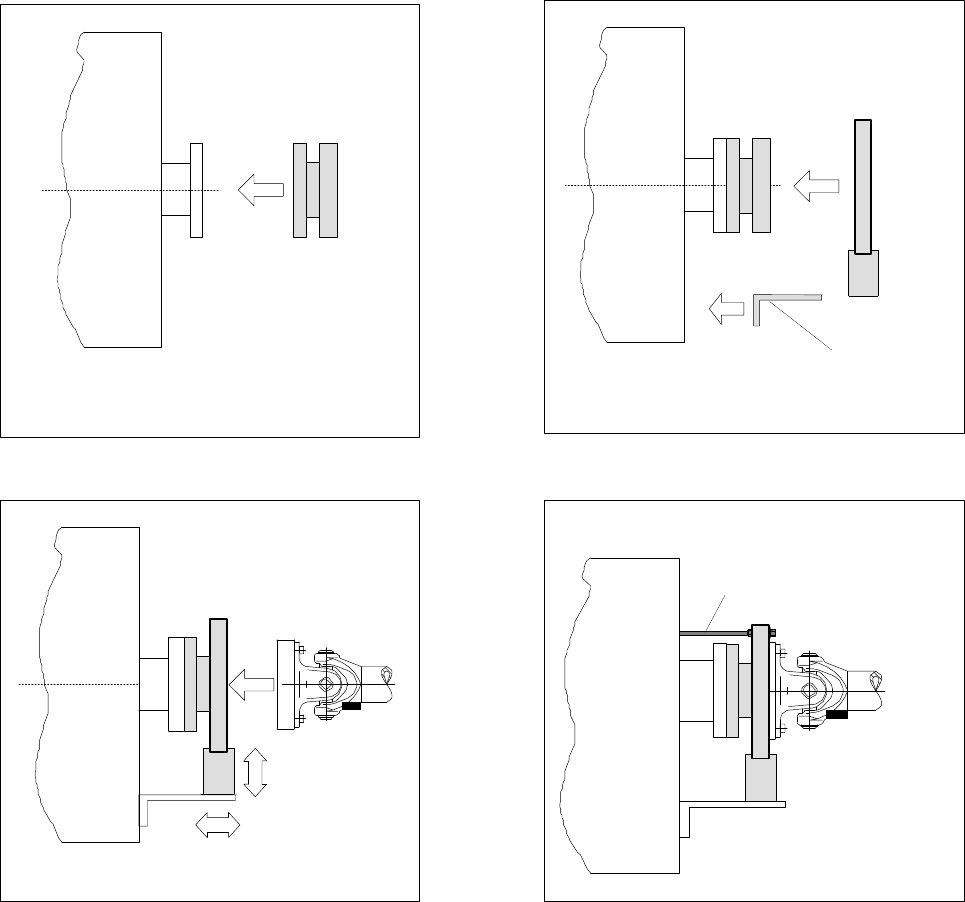
13
5.4.1 Installation without dismantling the antenna ring
Customer mounting
1. Mount rotor 2. Install stator
Support supplied by customer
3. Finish installation of shaft run 4. Mount support
Version b 13.01.2015 HBM: public
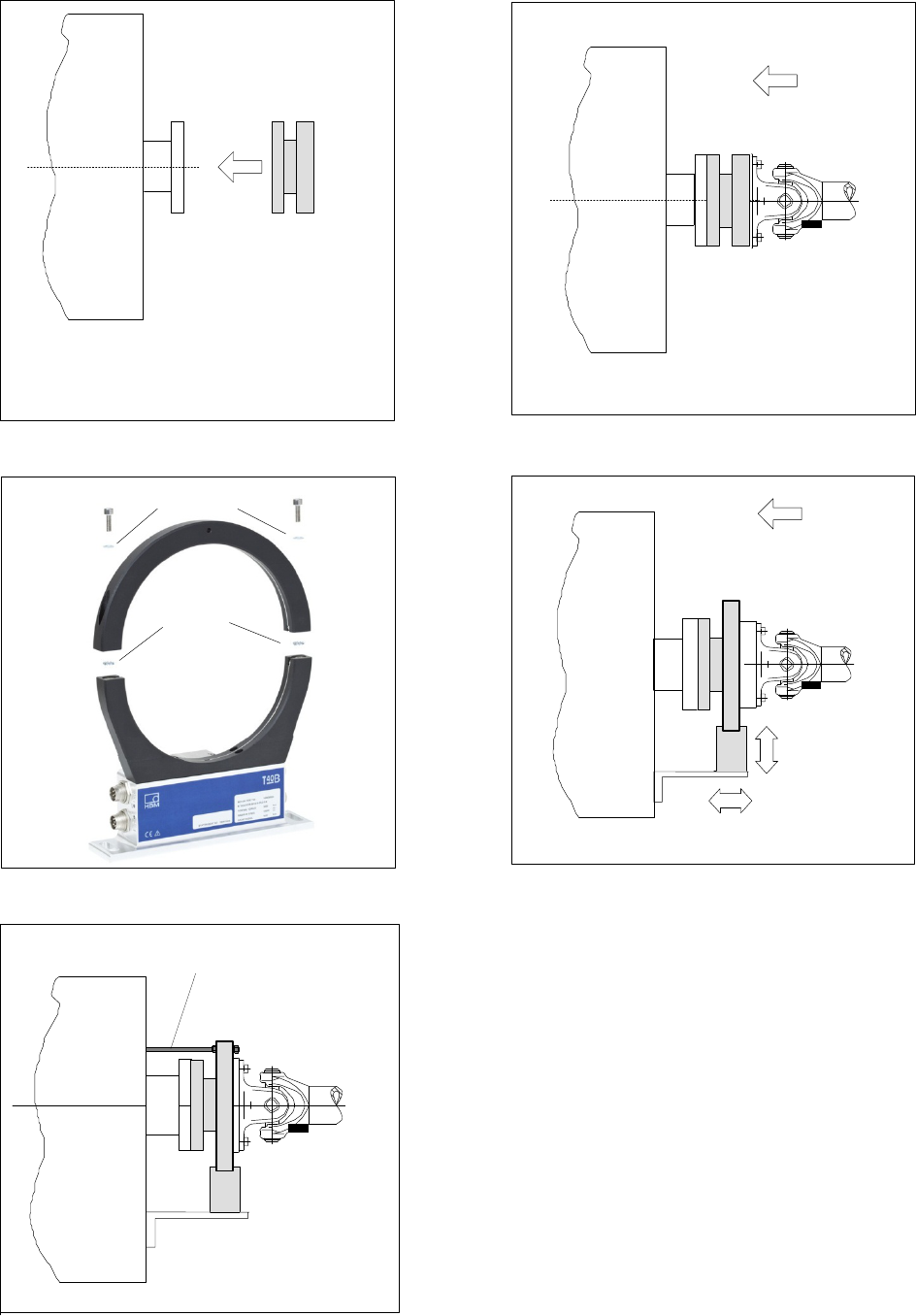
14
5.4.2 Installation with
subsequent
stator
mounting
1. Install rotor 2. Install shaft train
Washers
Fan-type lock
washers
3. Dismantle antenna segment 4. Install antenna segment
Support supplied by customer
4. Mount support
Version b 13.01.2015 HBM: public
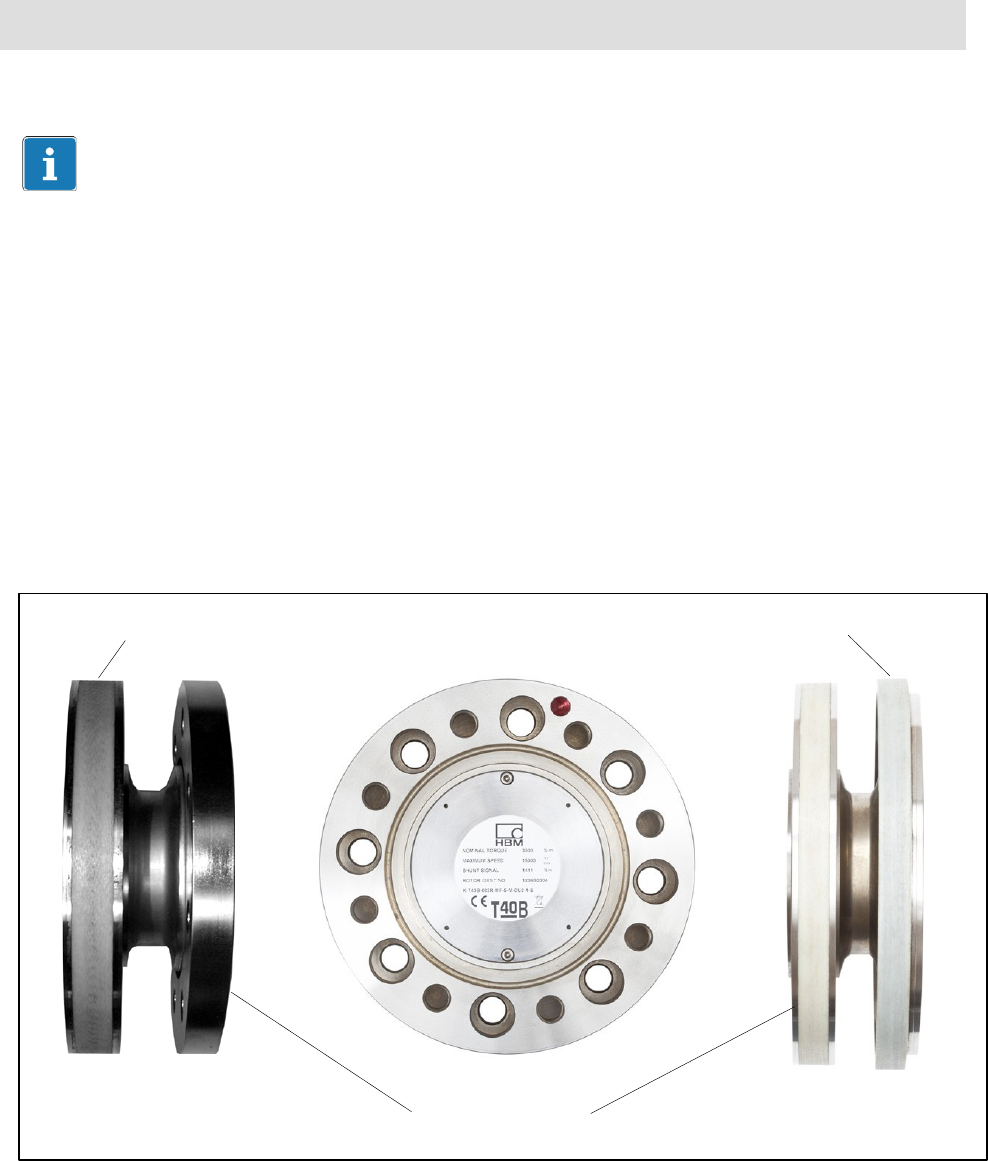
15
5.5 Mounting the rotor
T
ip
Usually the rotor identification plate is no longer visible after installation. This is why we
include with the rotor additional stickers with the important ratings, which you can attach to
the stator or any other relevant test-bench components. You can then refer to them
whenever there is anything you wish to know, such as the shunt signal.
1. Prior to installation, clean the plane surfaces of the transducer flange and the counter
flange.
For safe torque transfer, the surfaces must be clean and free from grease. Use a piece
of cloth or paper soaked in solvent. When cleaning, make sure that you do not damage
the transmitter winding or the speed measuring system.
Transmitter winding Speed measuring system
without speed
measuring
system
Flange plane
faces
with speed
measuring system
Fig. 5.9: Bolted rotor connection
Version b 13.01.2015 HBM: public

16
2. For the bolted rotor connection (see Fig. 5.9), use DIN EN ISO 4762 hexagon socket
screws of the property class stated in Table 4.1, in a suitable length (dependent on the
connection geometry, see Table 5.1 on Page 17).
We recommend DIN EN ISO 4762 fillister head screws, blackened, smooth-headed,
permitted size and shape variance in accordance with DIN ISO 4759, Part 1, product
class A.
Important
Use a screw locking device (medium strength, e.g. LOCTITE No. 242) to glue the screws
into the counter thread to exclude pre-stressing loss due to screw slackening, if alternating
loads are to be expected.
3. Fasten all screws with the specified torque
(Table 5.1 on Page 17).
4. There are tapped holes on the rotor for further mounting. Also use screws of property
class 10.9 or 12.9, and fasten with the torque specified in Table 5.1.
Important
Use a screw locking device (medium strength, e.g. LOCTITE No. 242) to glue the screws
into the counter thread to exclude pre-stressing loss due to screw slackening, if alternating
loads are to be expected.
Version b 13.01.2015 HBM: public
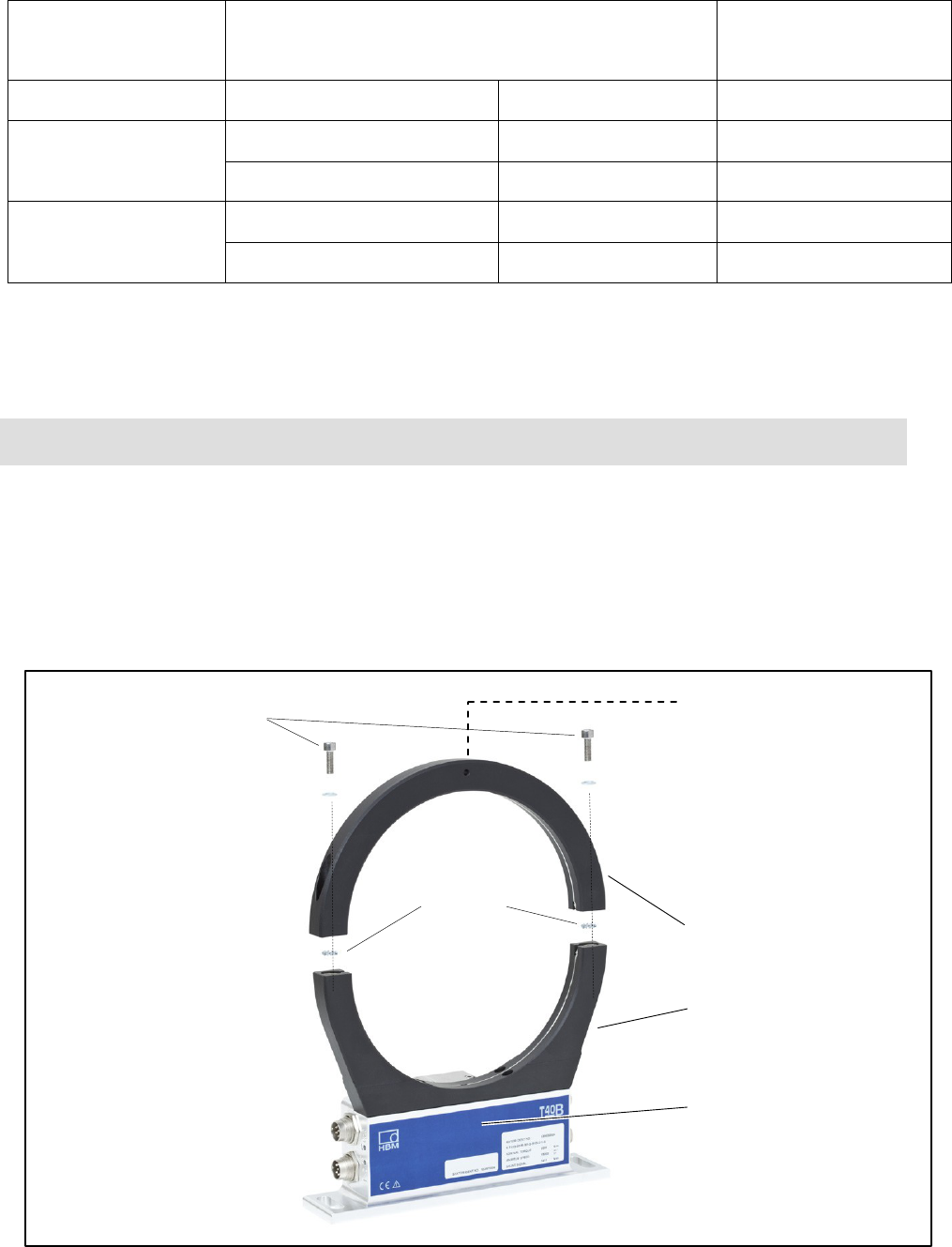
17
Measuring range Fastening screws Prescribed tightening
moment
kN·m Z 1) Property class N·m
15
M16
12.9
325
M20 12.9 397
25
M20
129
397
M24
12.9
245
Table 5.1: Fastening screws
1) DIN EN ISO 4762; black/oiled/..tot.=0.125
5.6 Mounting the
stator
On delivery, the stator has already been installed and is ready for operation. The upper
antenna segment can be separated from the stator, for example, for maintenance or to
facilitate stator mounting.
If your application does not require the stator to be dismantled, proceed as described in
points 2., 5., and 6.
Antenna segment bolts
with washers (M5)
Fan-type lock
washers
Hole for fixing the
antenna segment,
diameter 4.2 or 5.2
mm, depending on
maximum capacity
top
Antenna segments
bottom
Stator housing
Fig. 5.10: Bolted connection of the antenna segments on the stator
Version b 13.01.2015 HBM: public
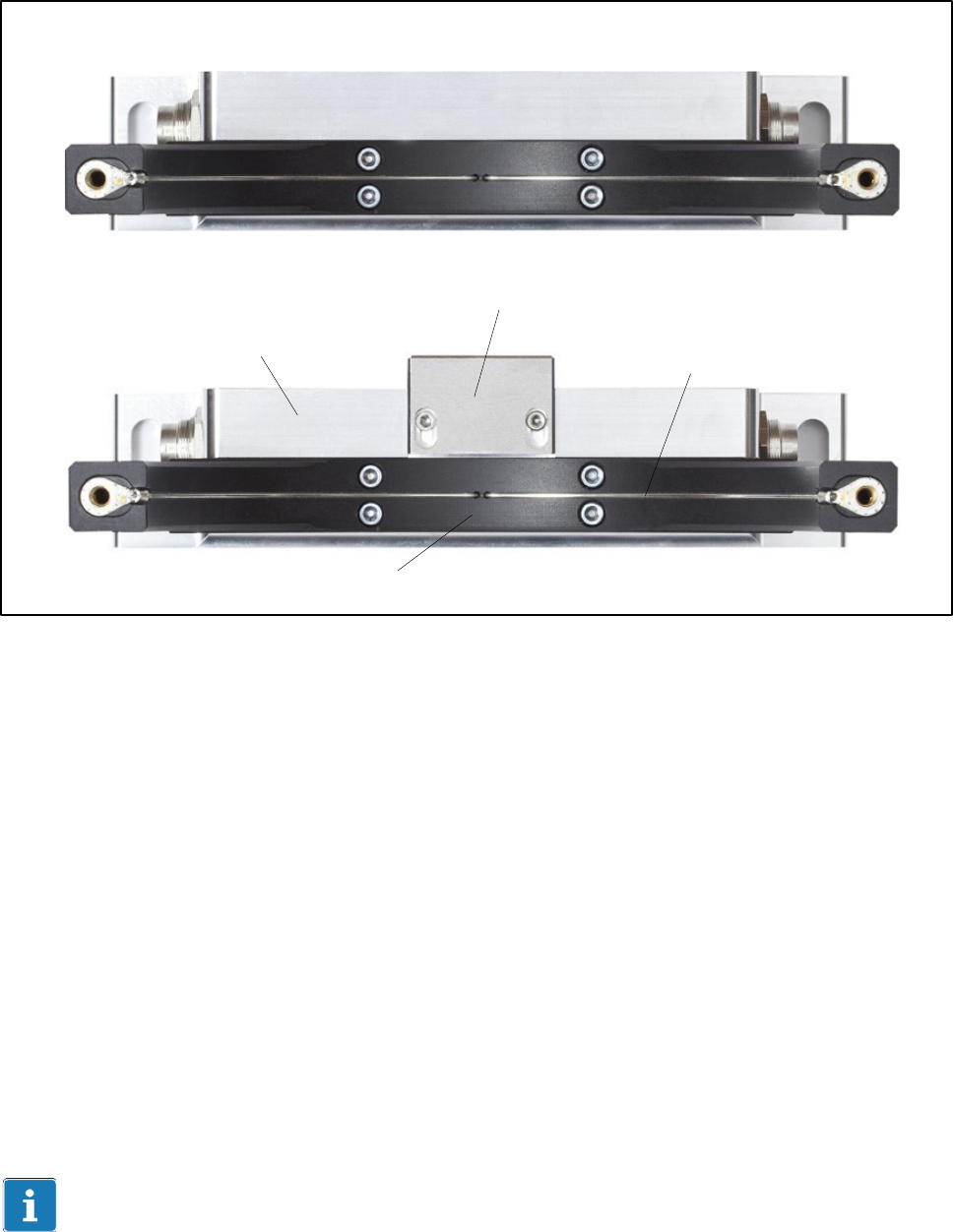
18
Transducer without speed measuring system
Transducer with speed measuring system
Sensor head for measuring speed
Stator housing
Antenna wire
Lower antenna segment
Fig. 5.11: Stator housing and lower antenna segment with antenna wire
1. Undo and remove the bolted connections (M5) on the upper antenna segment.
There are fan type lock washers between the antenna segments: Make sure that they do
not get lost.
2. Use an appropriate base plate to install the stator housing in the shaft train so that there
is sufficient opportunity for horizontal and vertical adjustments. Do not fully tighten the
bolts yet.
3. Now use two hexagon socket screws to mount the upper antenna segment removed
in Point 1 on the lower antenna segment.
Make sure that the two fan type lock washers are inserted between the antenna
segments (these ensure that there is a defined contact resistance)!
Important
To make sure that they function perfectly, the fan-type lock washers (A5, 3-FST DIN 6798
ZN/galvanized) must be replaced after the bolted antenna connection has been loosened
three times.
Version b 13.01.2015 HBM: public
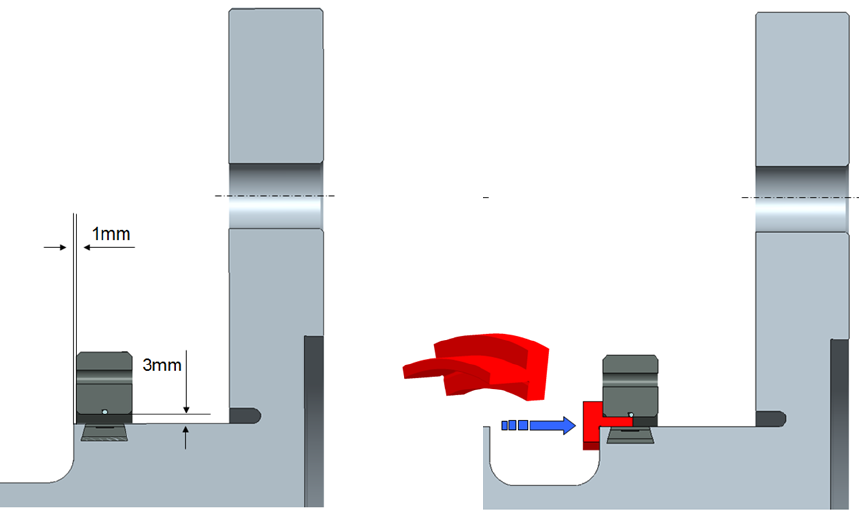
19
4. Now tighten all antenna-segment bolted connections with a tightening torque of 5 Nm.
5. Then align the antenna to the rotor in such a way that the antenna encloses the rotor
more or less coaxially and the antenna wire in the axial direction shows the position and
the center of the transmitter winding on the rotor.
Please comply with the permissible alignment tolerances stated in the specifications.
Fig. 5.12: Alignment of the rotor with the stator
6. Now fully tighten the bolted stator housing connection.
Prevention
of
stator
axial
oscillation
Depending on the operating conditions, the stator may be excited to vibrate. This effect is
dependent on:
• The rotational speed
• The antenna diameter (depends on the measuring range)
• The design of the machine base
Version b 13.01.2015 HBM: public
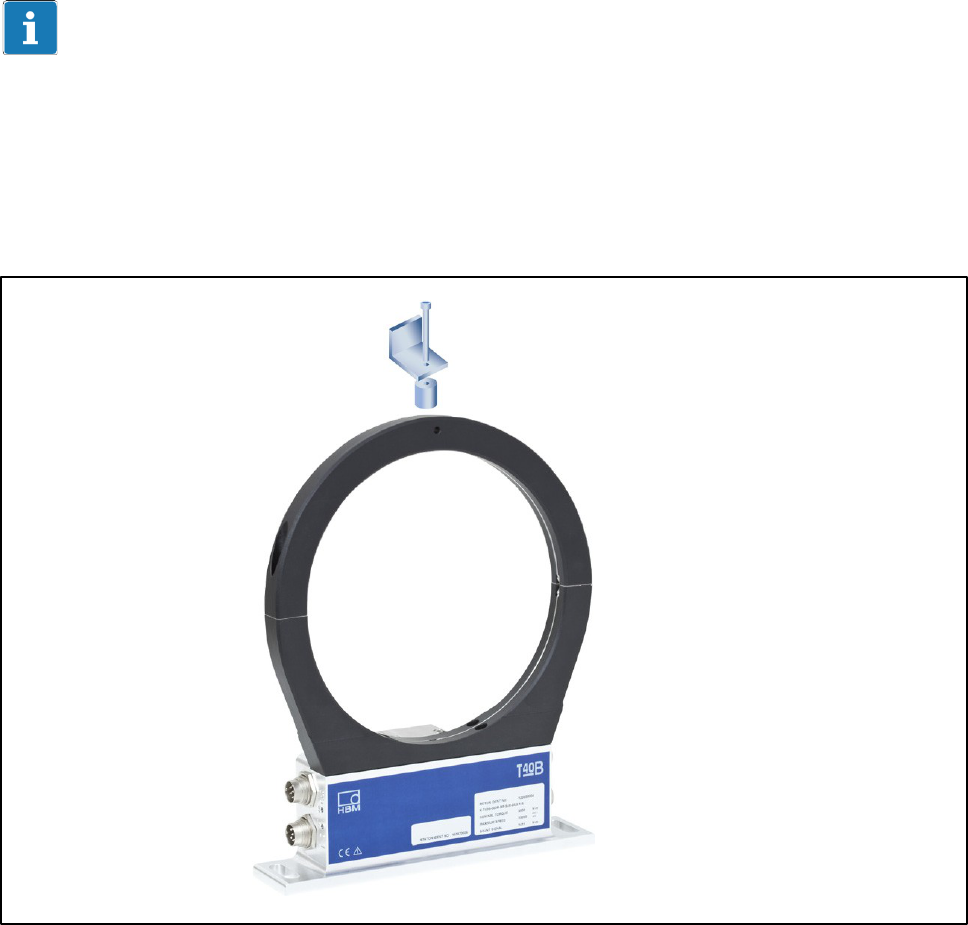
20
Important
To prevent this axial oscillation, the antenna ring requires additional support by the
customer. There is a hole on the upper antenna segment (with M5 internal thread), which
can be used to incorporate a clamping device (see Fig. 5.13).
The cable plug also requires support in this case, a construction example is shown in Fig.
5.14.
Fig. 5.13: Construction example for supporting the antenna ring
Version b 13.01.2015 HBM: public
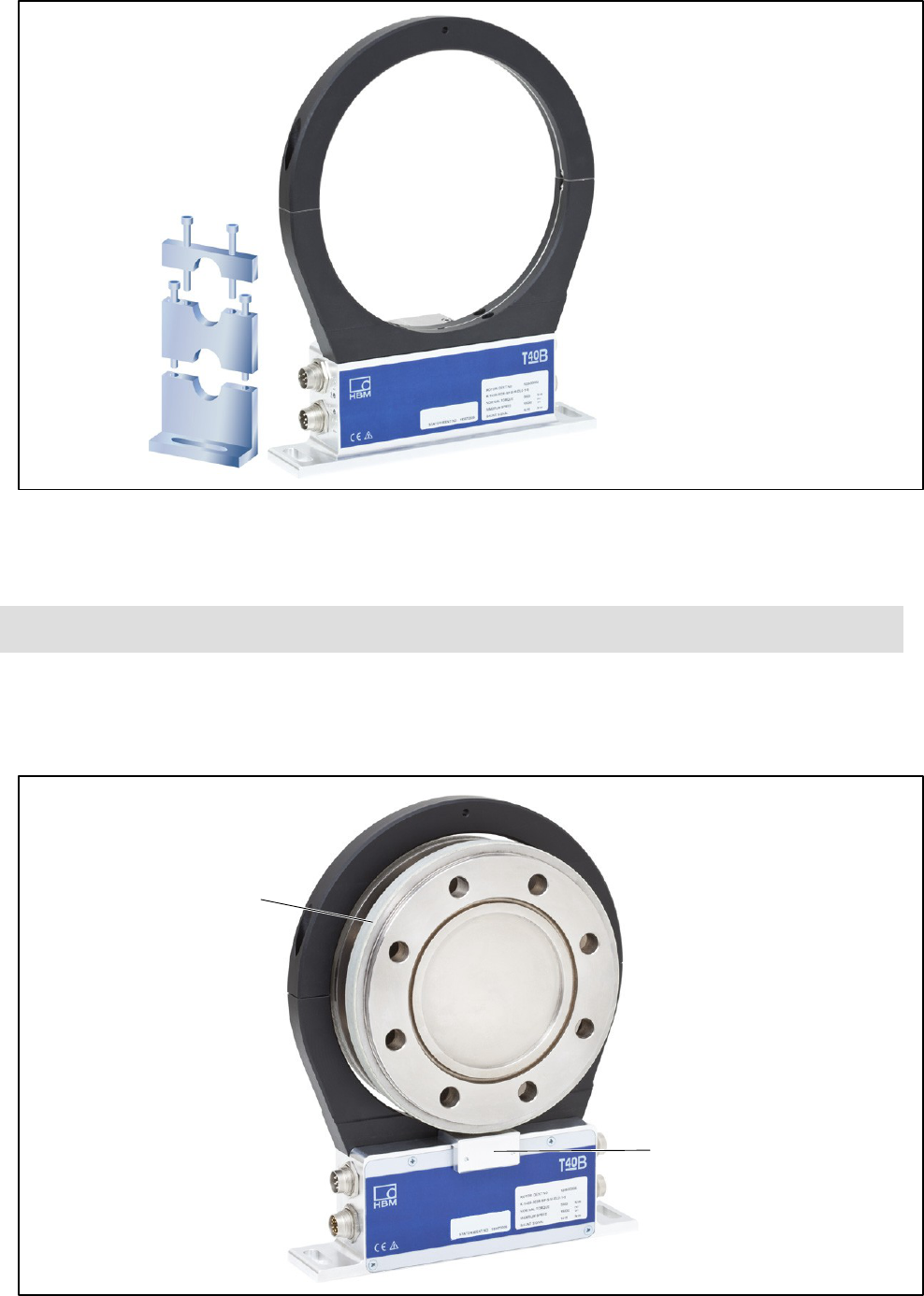
21
Fig. 5.14: Construction example for connector terminals (for two connectors)
5.7
Speed measuring system (optional)
The optional speed measuring system has already been integrated into the transducer at
the factory, no assembly is required.
Magnetic ring for
measuring the speed
Sensor head for
measuring the speed
Fig. 5.15: Torque transducer with speed measurement
Version b 13.01.2015 HBM: public
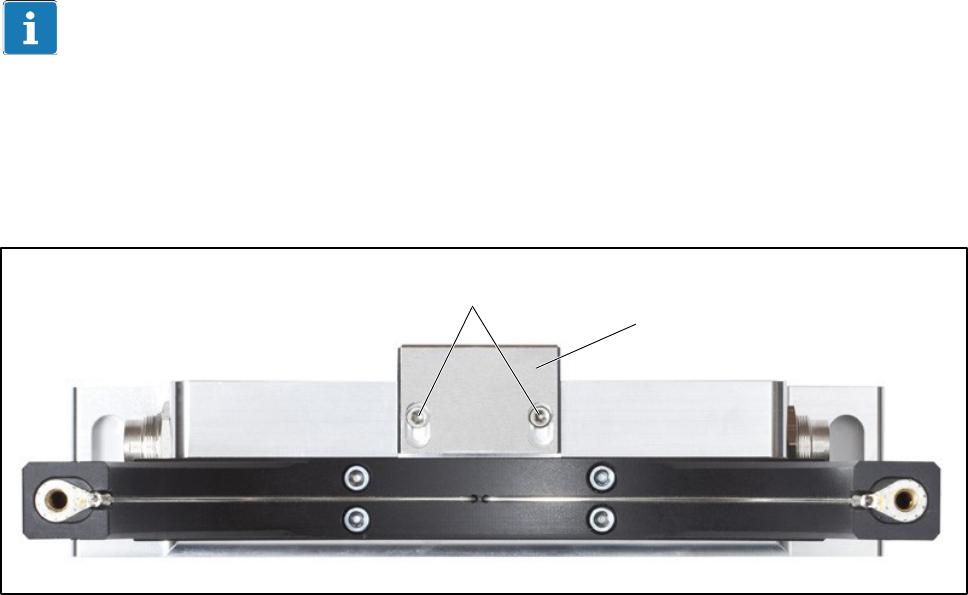
22
Speed measuring system
sensor
head alignment
The speed measuring system is correctly aligned when the stator is precisely aligned for
the torque measurement. So the two Allen screws on the sensor head (Fig. 5.16) must
not be loosened.
Important
You must not change the position of the sensor head.
Never loosen the
screws!
Sensor head for
measuring the speed
Fig. 5.16: Torque transducer with sensor head for speed measurement
Version b 13.01.2015 HBM: public

23
6
Electrical connection
6.1
General instructions
• With cable extensions, make sure that there is a proper connection
with minimum contact resistance and good insulation.
• All plug connections or swivel nuts must be fully tightened.
Important
Transducer connection cables from HBM with attached connectors are identified in
accordance with their intended purpose (Md or n). When cables are shortened, inserted into
cable ducts or installed in control cabinets, this identification can get lost or become
concealed. Mark the cables before laying them in this case.
6.2 EMC
protection
Important
The product offered here is a special module for stationary plants or a transducer for
installation by system integrators or plant engineers and is not intended for general sale.
This product does not need an EC Declaration of Conformity or CE marking in compliance
with EMVG1 §12 Paragraph 2 and directive 2004/1008/EC Article 13 Paragraph 1.
The product is exclusively manufactured and intended for further processing by companies
or persons with expertise in the sector of electromagnetic compatibility (EMC). Relevant
EMC protection aims are met with regards to the offered product when the following
instructions for installation are observed and implemented.
Special electronic coding methods are used to protect the purely digital signal
transmission between the transmitter head and the rotor from electromagnetic
interference.
Version b 13.01.2015 HBM: public
24
The cable shield is connected with the transducer housing. This encloses the measurement
system (without the rotor) in a Faraday cage when the shield is laid flat at both ends of the
cable. With other connection techniques, an EMC-proof shield should be applied in the wire
area and this shielding should also be connected extensively (see also HBM Greenline
Information, brochure i1577).
Electrical and magnetic fields often induce interference voltages in the measuring circuit.
Therefore:
• Use shielded, low-capacitance measurement cables only (HBM cables fulfill both
conditions).
• Only use plugs that meet EMC guidelines.
• Do not route the measurement cables parallel to power lines and control circuits.
If this is not possible, protect the measurement cable with e.g. steel conduit.
• Avoid stray fields from transformers, motors and contact switches.
• Do not ground the transducer, amplifier and indicator more than once.
• Connect all devices in the measurement chain to the same grounded conductor.
• In the case of interference due to potential differences (compensating currents),
supply voltage zero and housing ground must be disconnected on the amplifier and a
potential equalization line established between the stator housing and the amplifier
housing (copper conductor, minimum 10 mm2 wire cross-section).
• Should differences in potential between the machine rotor and stator, because of
unchecked leakage, for example, cause interference, this can usually be overcome
by connecting the rotor definitively to ground, e.g. with a wire loop. The stator must
be connected to the same (ground) potential.
Version b 13.01.2015 HBM: public
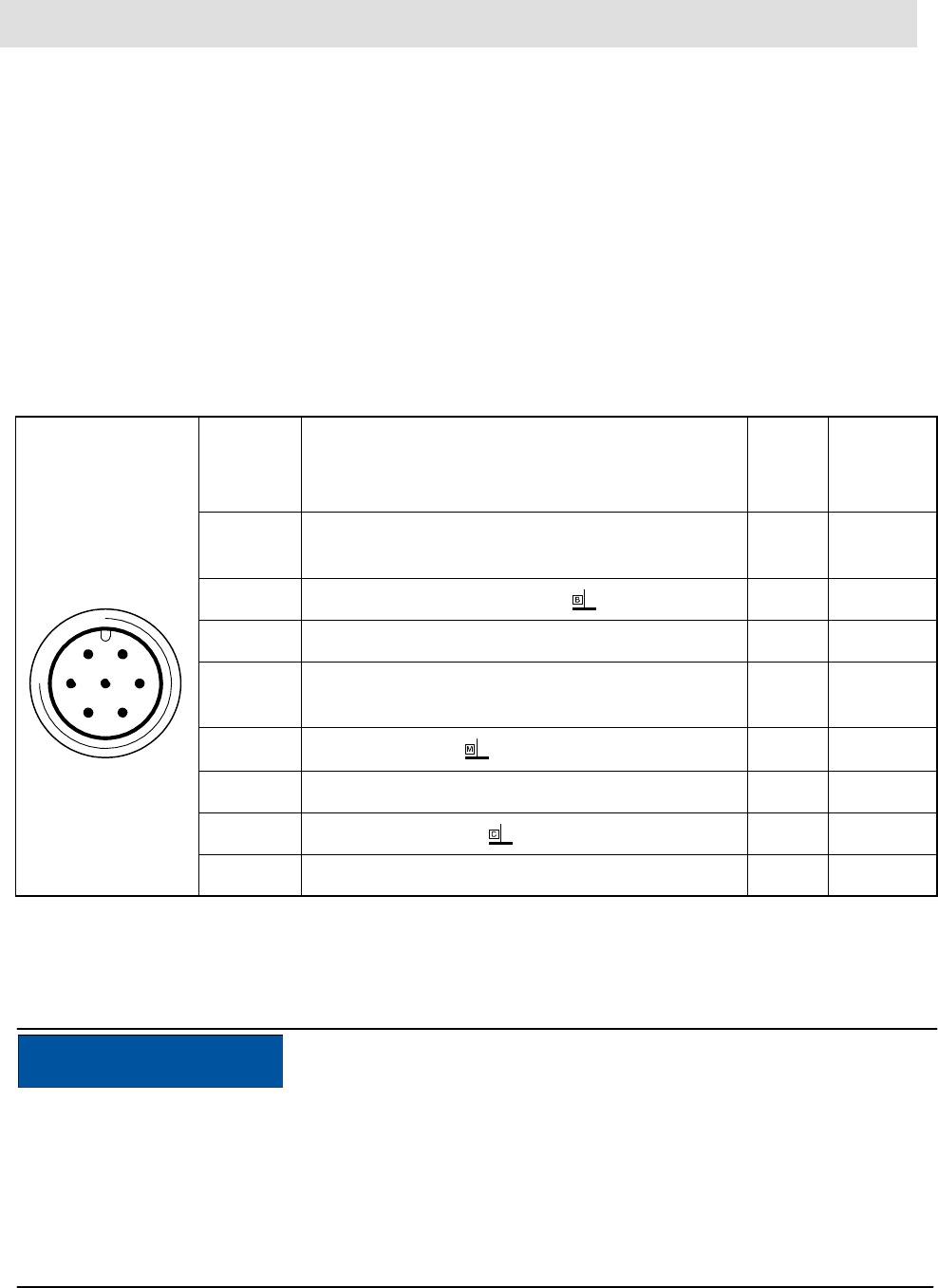
25
Device
connector
6 1
5 7 2
4 3
Top view
Plug
Pin
Assignment
Wire
color
D‐Sub
Plug
Pin
1
Measurement signal torque
(Frequency output; 5 V1),2))
wh
13
2
Supply voltage 0 V;
bk 5
3
Supply voltage 18 V - 30 V
bu 6
4
Measurement signal torque
rd
12
5 Meas. signal 0 V; symmetrical gy 8
6
Shunt signal resolution 5 V
…
30 V
gn 14
7
Shunt signal 0 V;
gy 8
Shielding connected to housing ground
6.3
Connector pin assignment
The stator housing has two 7 pin connectors, an 8 pin connector and a 16 pin connector.
The supply voltage connections and shunt signal connections of connectors
1 and 3 are each electrically interconnected, but are protected against compensating
currents by diodes. There is also an automatically resetting fuse (multifuse) to protect the
supply connections against overload by the stator.
Assignment for connector
1:
Supply voltage and frequency output signal.
(Frequency output; 5 V1),2))
1) RS-422 complementary signals; with cable lengths exceeding 10 m, we recommend
using a termination resistor R = 120 ohms between the (wh) and (rd) wires.
2) RS‐422: Pin 1 corresponds to A, Pin 4 corresponds to B.
NOTE
These torque flanges are only intended for operation with a DC supply voltage. They must
not be connected to older HBM amplifiers with square-wave excitation. This could destroy
the connection board resistances or cause other faults in the amplifiers.
Version b 13.01.2015 HBM: public
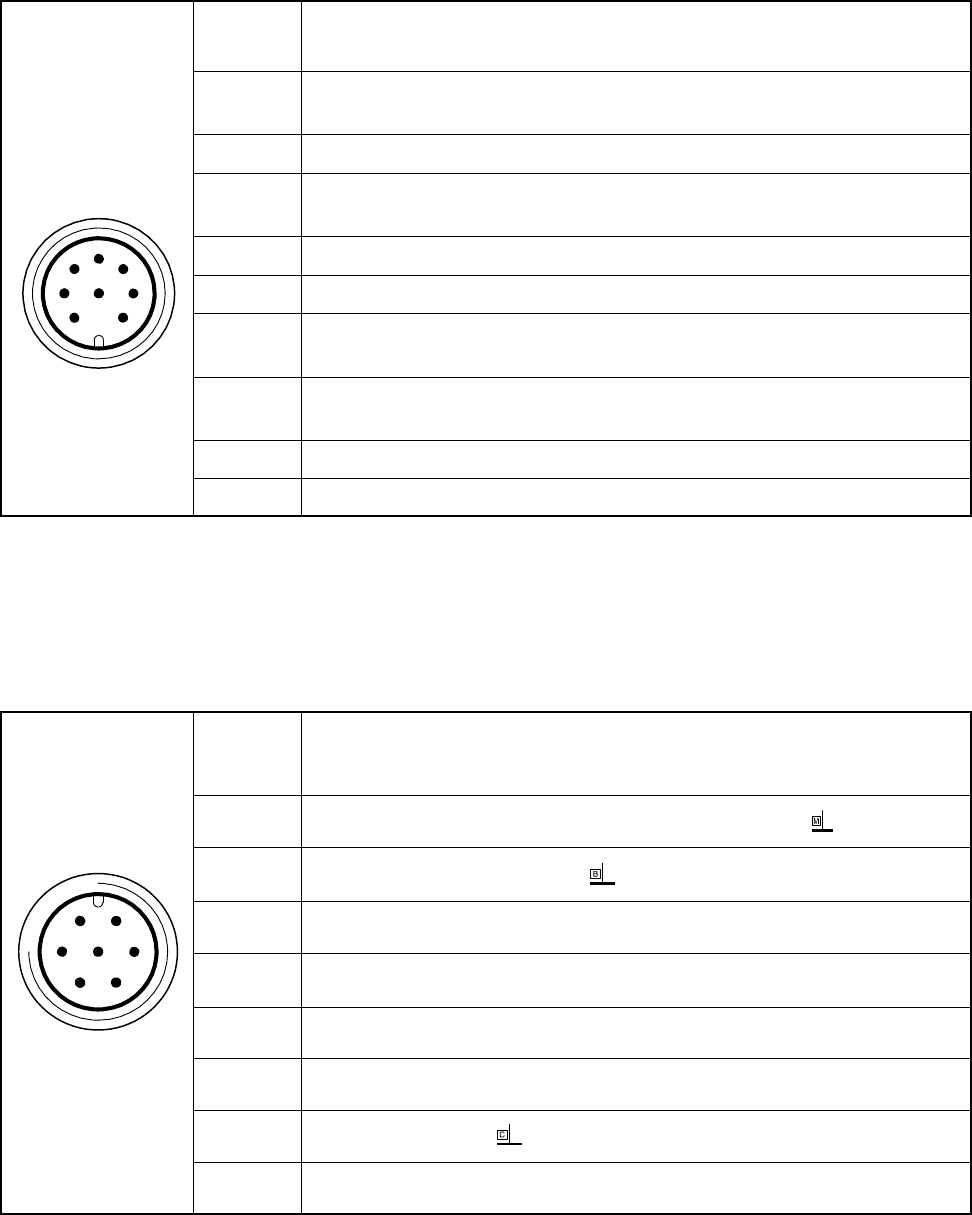
26
Assignment for connector
2:
Speed output signal (optional).
Device
connector
2
5 4
3 8 1
7 6
Top view
Plug
Pin
Assignment
1
Measurement signal speed 1)
(pulse string, 5 V; 0°)
2
Not in use
3
Measurement signal speed 1)
(pulse string, 5 V; phase shifted by 90°)
4
Not in use
5
Not in use
6
Measurement signal speed 1)
(pulse string, 5 V; 0°)
7
Measurement signal speed 1)
(pulse string, 5 V; phase shifted by 90°)
8
Supply voltage zero
Shielding connected to housing ground
1) RS-422 complementary signals; with cable lengths exceeding 10 m, we recommend
using a termination resistor of R = 120 ohms.
Assignment for connector
3:
Supply voltage and frequency output signal.
Device
connector
6 1
5 7 2
4 3
Top view
Plug
Pin
Assignment
1 Torque measurement signal (volt. output; 0 V )
2 Power supply 0 V;
3 Supply voltage 18 V - 30 V DC
4 Torque measurement signal (voltage output,
±10
V)
5 Not in use
6 Shunt signal resolution 5 V - 30 V
7 Shunt signal 0 V;
Shielding connected to housing ground
Assignment for connector
4:
TMC
-
only for connection to the TIM 40 Torque Interface Module within HBM.
Version b 13.01.2015 HBM: public

27
6.4 S
upply voltage
The transducer is operated with a separated extra-low voltage (nominal (rated) supply
voltage 18 - 30 VDC). You can supply one or more torque flanges simultaneously within a
test bench. Should the device be operated on a DC voltage network1) , additional
precautions must be taken to discharge excess voltages.
The information in this Chapter relates to the standalone operation of the T40FM without
HBM system solutions.
The supply voltage is electrically isolated from signal outputs and shunt signal inputs.
Connect a separated extra-low voltage of 18 V - 30 V to pin 3 (+) and pin 2 (-)
of plug 1 or 3. We recommend that you use HBM cable KAB 8/00-2/2/2 and appropriate
sockets (see Accessories). The cable can be up to 50 m long for voltages ≥24 V,
otherwise it can be up to 20 m long.
If the permissible cable length is exceeded, you can supply the voltage in parallel over two
connection cables (connectors 1 and 3). This enables you to double the permissible length.
Alternatively, install a power supply on site.
Important
At the instant of power-up, a current of up to 4 A may flow, which could switch off power
packs with electronic current limiters.
Version b 13.01.2015 HBM: public

28
7
Shunt signal
The torque flange delivers an electrical shunt signal that in measuring chains with HBM
components, can be activated from the amplifier. The transducer generates a shunt signal
of about 50% of the nominal (rated) torque, the precise value is specified on the type
plate. After activation, adjust the amplifier output signal to the shunt signal supplied by the
connected transducer to adapt the amplifier to the transducer.
The transducer should not be under load when the shunt signal is being measured, since the
shunt signal is mixed additively.
Triggering
the
shunt signal
Applying a separated extra-low voltage of 5 - 30 V to pins 6 (+) and 7 (-) at connector 1
or 3 triggers the shunt signal.
The nominal (rated) voltage for triggering the shunt signal is 5 V (triggering at U > 2.5 V),
but when voltages are less than 0.7 V, the transducer is in measuring mode. The
maximum permissible voltage is 30 V, current consumption at nominal (rated) voltage is
approx. 2 mA and at maximum voltage, approx. 18 mA. The trigger voltage for the shunt
signal is electrically isolated from the supply voltage and the measurement voltage.
T
ip
The shunt signal can be triggered by the amplifier or via the operating software in HBM
system solutions.
Version b 13.01.2015 HBM: public
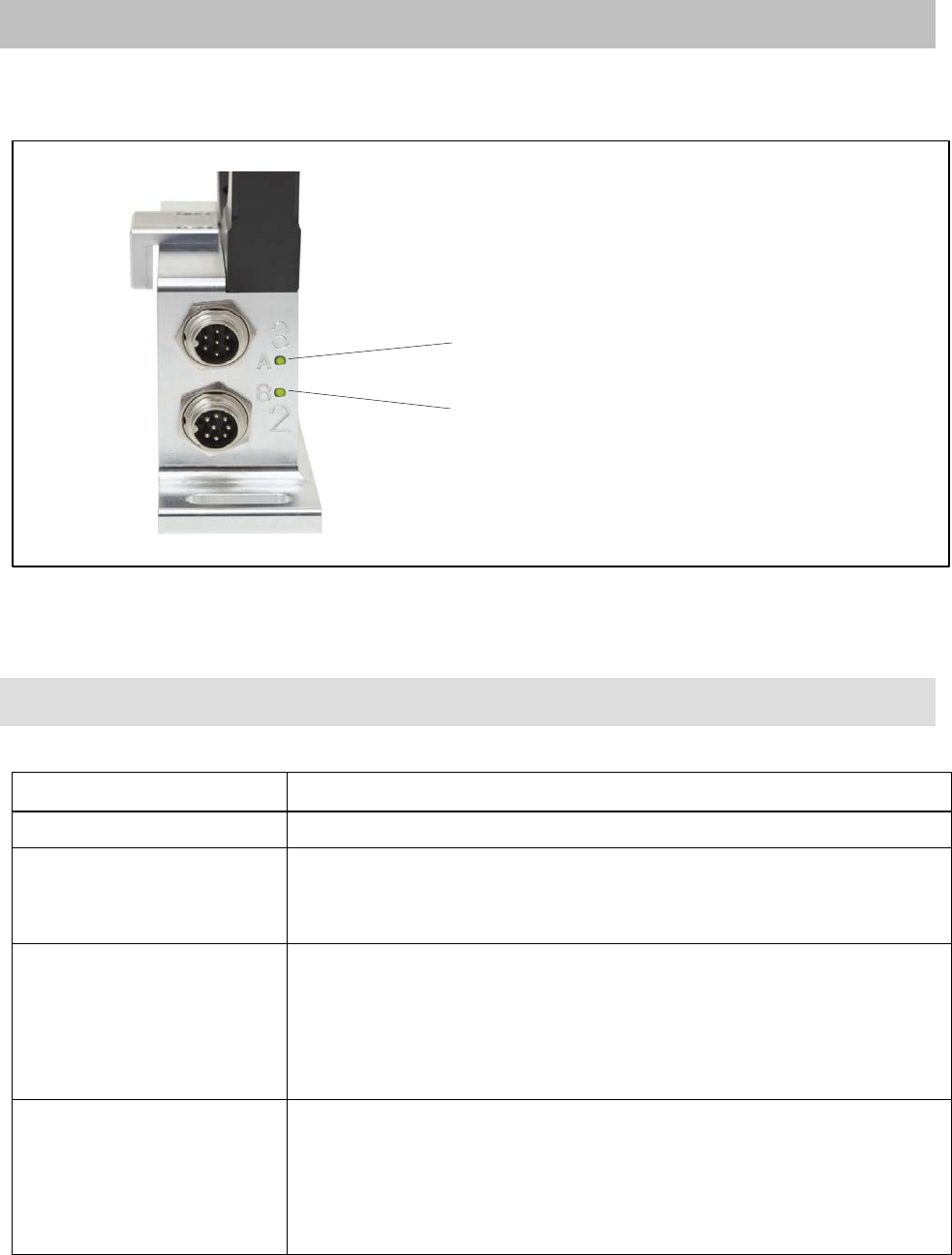
29
8 Functionality testing
You can check the
functionality
of the rotor and the
stator
from the LEDs on the stator.
LED A rotor status
LED B stator status
Fig. 8.1: LEDs on the stator housing
8.1
Rotor status
,
LED A (upper
LED)
Color
Meaning
Green (pulsating) Internal rotor voltage values OK
Flashing orange Rotor and stator mismatched (an increasing flashing frequency
indicates the
degree of misalignment)
=> Correct the rotor/stator alignment.
Pulsating orange
Rotor status cannot be defined
=> Correct the rotor/stator alignment.
If the LED still pulsates orange, it is possible that there is a hardware
defect. The measurement signals reflect the level of the defect status.
Red (pulsating)
Rotor voltage values NOK.
=> Correct the rotor/stator alignment.
If the LED still pulsates red, it is possible that there is a hardware defect.
The measurement signals reflect the level of the defect status.
Pulsating means that the LED goes dark for about 20 ms every second (sign of life); making
it possible to detect that the transducer is functioning.
Version b 13.01.2015 HBM: public

30
8.2 Stator status, LED B (lower LED)
Color
Meaning
Green
(permanently lit)
Measurement signal transmission and internal stator voltages OK
Green, intermittently orange.
For many synchronization
errors:
Constant orange
Orange until end of defective transmission if ≥5 incorrect measured values
in sequence are transmitted. The measurement signals reflect the level of
the defect status for the duration of the transmission defect + approx.
another 3.3 ms.
Orange
(permanently lit)
Permanently disrupted transmission, the measurement signals reflect the
level of the defect status. (fout = 0 Hz, Uout = defect level).
=> Correct the rotor/stator alignment.
Red
(permanently lit)
Internal stator defect, the measurement signals reflect the level of the
defect
status (f
out
= 0 Hz, U
out
= defect level).
Version b 13.01.2015 HBM: public
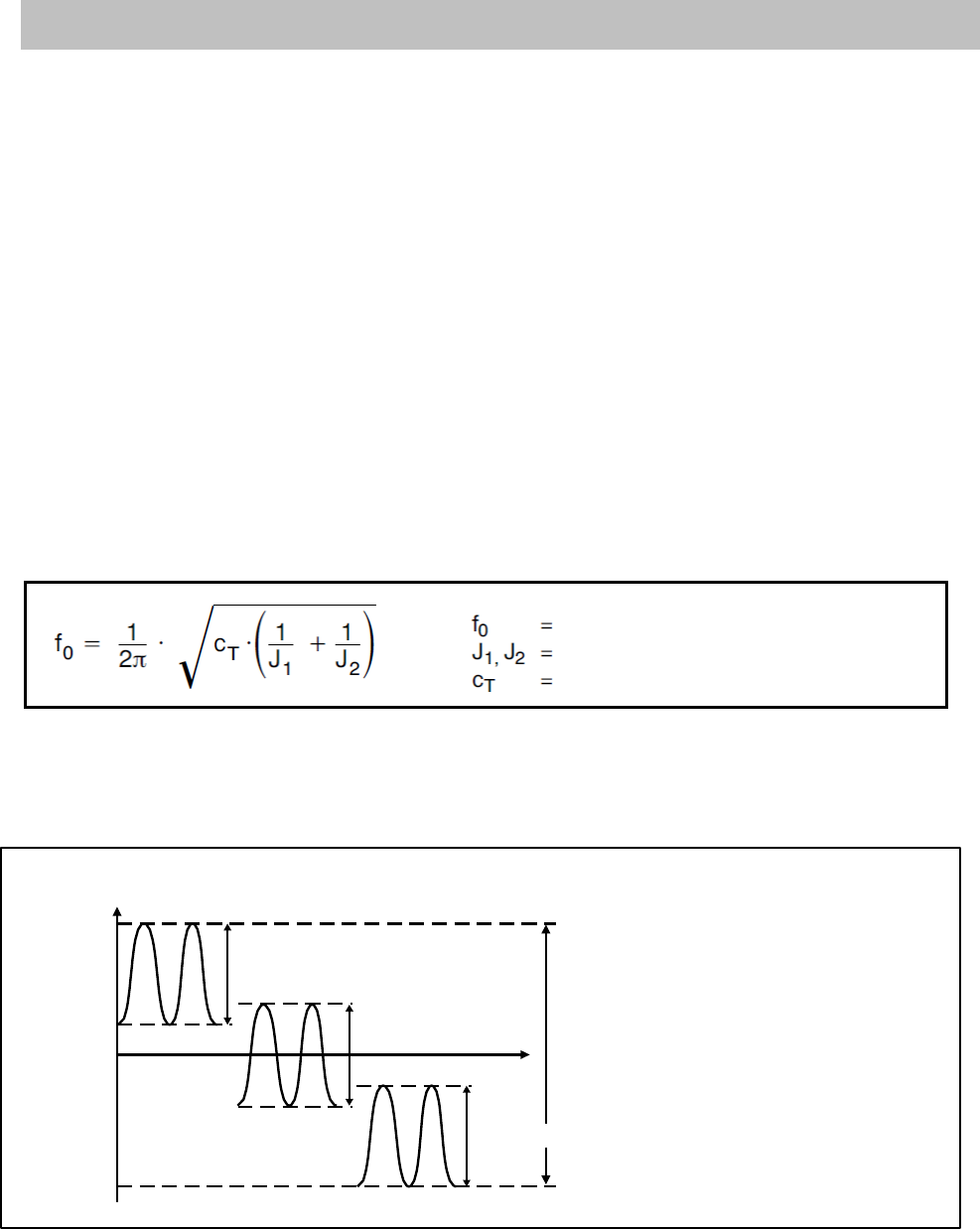
31
9
Loading capacity
Nominal torque can be exceeded statically up to the limit torque. If the nominal torque is
exceeded, additional irregular loading is not permissible. This includes longitudinal forces,
lateral forces and bending moments. Limit values can be found in the chapter
"Specifications" (Chapter 13, Page 115).
Measuring
dynamic torque
The torque flange can be used to measure static and dynamic torques. The following rule
applies to the measurement of dynamic torque:
• The transducer calibration performed for static measurements is also valid for
dynamic torque measurements.
• The natural frequency f0 of the mechanical measurement setup depends on the
moments of inertia J1 and J2 of the connected rotating masses, and the torsional
stiffness of the transducer.
Use the equation below to approximately determine the natural frequency f0 of the
mechanical measuring arrangement:
• The permissible mechanical vibration bandwidth (peak-peak) can also be
found in the specifications.
Nominal (rated) torque Mnom in %
+ Mnom
Oscillation width
Oscillation width
0 time
t
200% oscillation width
-
Mnom
Oscillation width
Fig. 9.1: Permissible dynamic loading
Natural frequency in Hz
Mass moment of inertia in kg·m^2
Torsional stiffness in N m/rad
Version b 13.01.2015 HBM: public
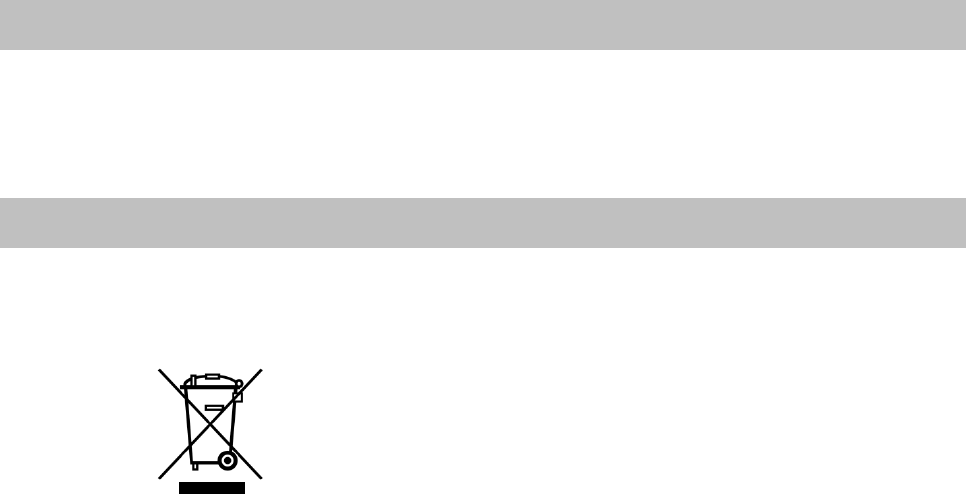
32
10 M
aintenance
The torque flanges are maintenance-free.
11
Waste disposal
and
environmental protection
All electrical and electronic products must be disposed of as hazardous waste. The
correct disposal of old equipment prevents ecological damage and health hazards.
Symbol:
Meaning: Statutory
waste disposal mark
The electrical and electronic devices that bear this symbol are subject to the European
waste electrical and electronic equipment directive 2002/96/EC. The symbol indicates that,
in accordance with national and local environmental protection and material recovery and
recycling regulations, old devices that can no longer be used must be disposed of
separately and not with normal household garbage.
As waste disposal regulations may differ from country to country, we ask that you contact
your supplier to determine what type of disposal or recycling is legally applicable in your
country.
P
ackaging
The original packaging of HBM devices is made from recyclable material and can be sent
for recycling. Store the packaging for at least the duration of the warranty. In the case of
complaints, the torque flange must be returned in the original packaging.
For ecological reasons, empty packaging should not be returned to us.
Version b 13.01.2015 HBM: public
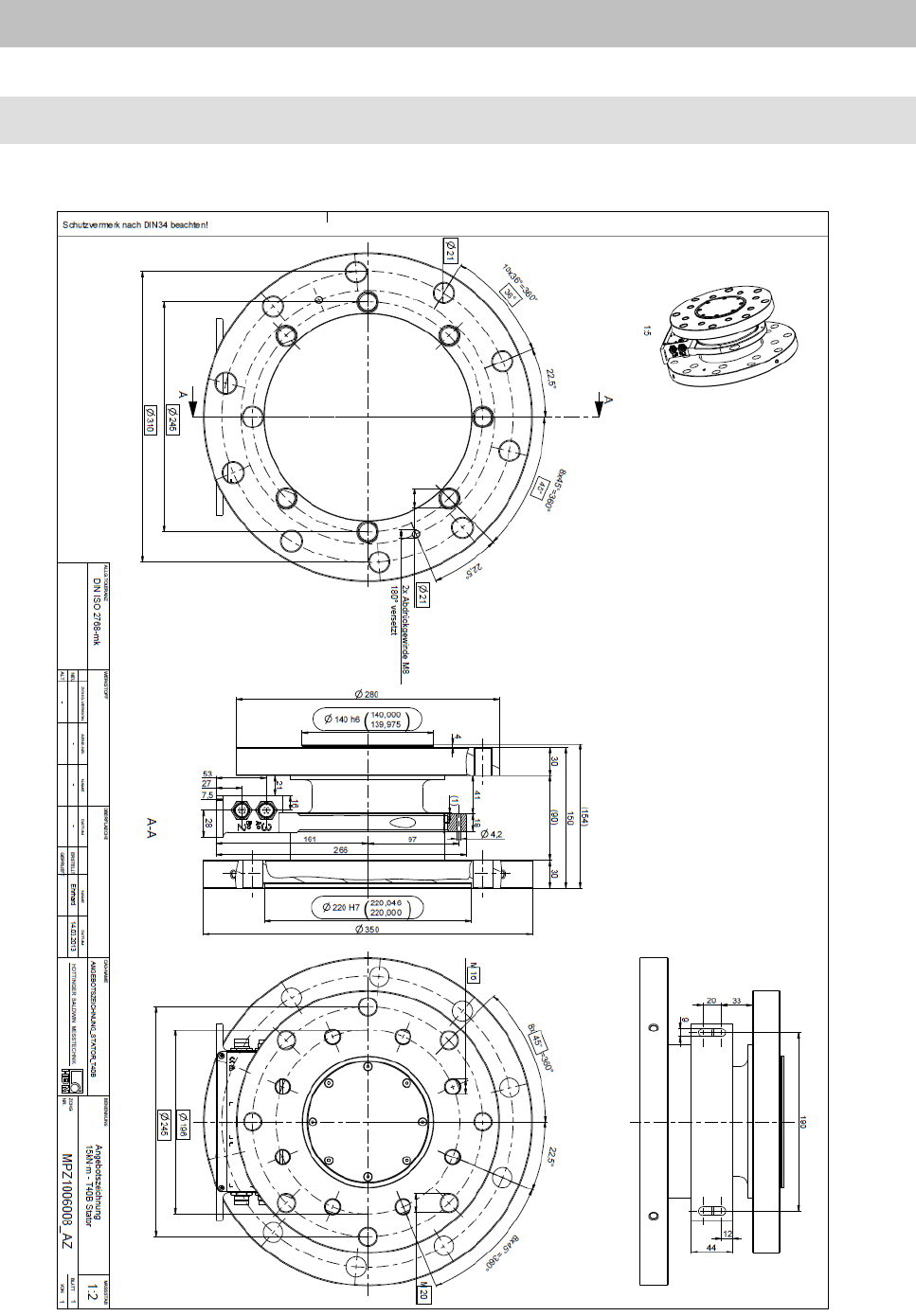
33
12
Dimensions
12.1
Torque flange - 15kN·m
Version b 13.01.2015 HBM: public
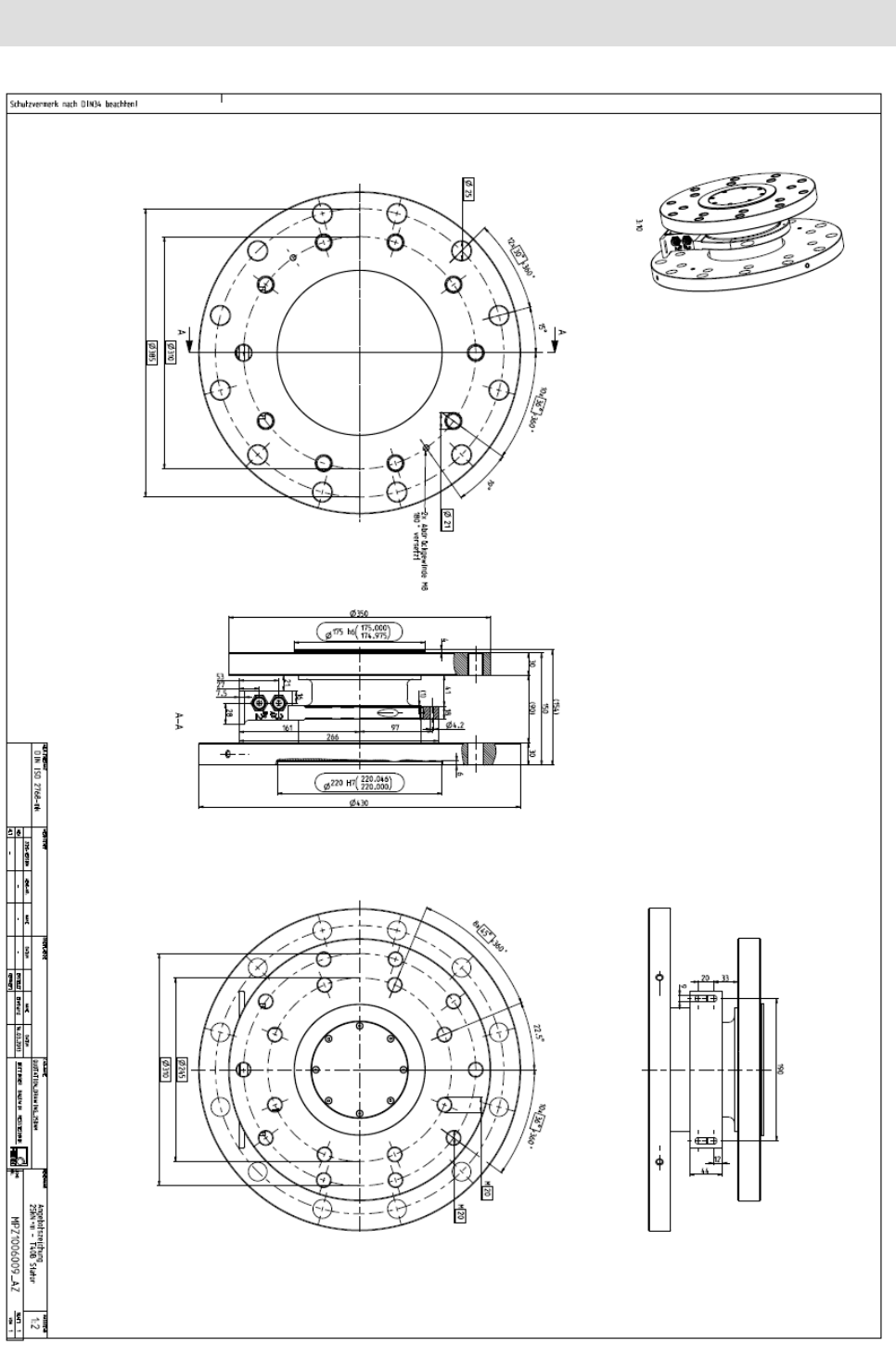
34
12.2 Torque flange - 25kN·m
Version b 13.01.2015 HBM: public
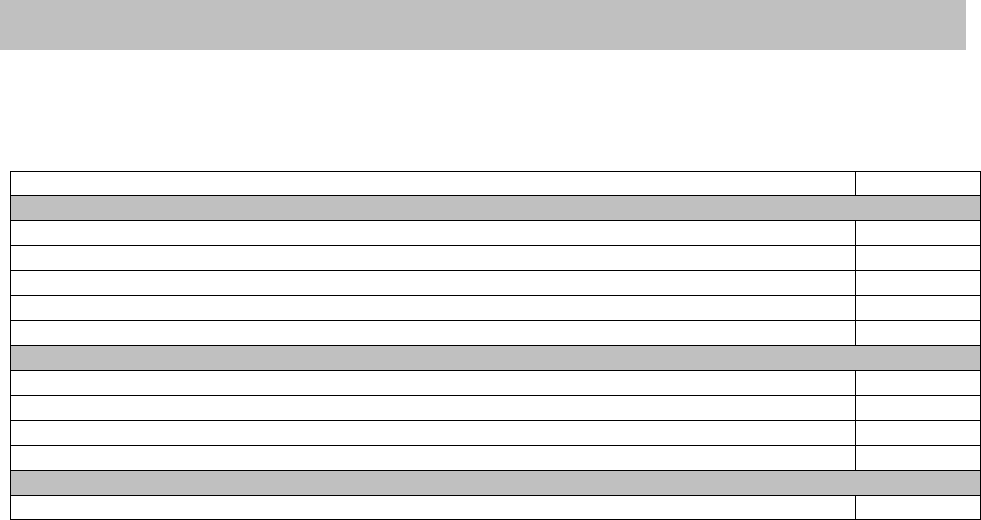
35
13
Order numbers, accessories
Accessories,
to
be ordered
separately
Article
Order No.
Connection cable,
set
Torque connection cable, Binder 423
-
D-Sub 15P, 6 m
1-KAB149-6
Torque connection cable, Binder 423
-
free ends, 6 m
1-KAB153-6
Speed connection cable, Binder 423
-
8 pin, free ends, 6 m
1-KAB154-6
Speed connection cable, Binder 423
-
8 pin, D‐Sub, free ends, 6 m
1-KAB163-6
TMC connection cable, Binder 423
-
16 pin, free ends, 6 m
1-KAB174-6
Cable sockets
423G-7S, 7 pin (straight)
3-3101.0247
423W-7S, 7 pin (angle)
3-3312.0281
423G-8S, 8-pin (straight)
3-3312.0120
423W-8S, 8 pin (angle)
3-3312.0282
Connection cable,
by the meter
(minimum order quantity:
10 m, price per
meter)
Kab8/00-2/2/2
4-3301.0071
Version b 13.01.2015 HBM: public

36
14
Specifications
Ty
pe
MPZ1006008-12 / MPZ1006009-12
Accuracy class
0.1
Torque measuring system
Nominal (rated) torque M
nom
kN⋅m
15
25
Nominal (rated) sensitivity
(spread between torque =
zero and nominal (rated) torque)
Freq. output 10 kHz / 60 kHz / 240 kHz
Voltage output
Sensitivity tolerance
(deviation of the actual output
quantity at Mnom from the nominal (rated) sensitivity)
Voltage output
kHz
V
%
30
10
±
0.1
Output signal
at
torque
=
zero
Frequency output
Voltage output
kHz
V
60
0
Nominal output signal
Frequency output
at positive nominal (rated) torque
at negative nominal (rated) torque
Voltage output
at positive nominal (rated) torque
at negative nominal (rated) torque
kHz
kHz
V
V
90 2)
(5 V symmetrical 4))
30 2)
(5 V symmetrical 4))
+10
-10
Load resistance
Frequency output
Voltage output
Long-term drift
over 48
h
Frequency output
Voltage output
kΩ
kΩ
%
%
≥ 2
≥10
<
±
0.03
<
±
0.03
Measurement frequency range,
-3
dB
kHz
3 2)
Group delay
µs
<
220 2)
Residual ripple
Voltage output 5)
mV
<
40
Temperature influence
per 10 K
in the
nominal
temperature range
on the
output signal,
related to
the
actual value of the
signal span
Frequency output
Voltage output
on the
zero signal,
related to the
nominal (rated)
sensitivity
Frequency output
Voltage output
%
%
%
%
±
0.05
±
0.2
±
0.05
±
0.1
Version b 13.01.2015 HBM: public

37
Maximum
level control range
6)
Frequency output
Voltage output
kHz
V
15 - 105 2)
-12 - +12
Energy supply
Nominal (rated) supply voltage (separated extra low
DC voltage)
Current consumption in measuring mode
Current consumption in startup mode
Nominal (rated) power consumption
Maximum cable length
V
A
A
W
m
18 - 30
< 1
< 4 (typ. 2) 50 µs
< 10
50
Linearity deviation,
including
hysteresis,
relative to nominal (rated) sensitivity
Frequency output
Voltage output
Rel.
Standard deviation
of
repeatability
as per DIN 1319, relative to the variation of the output
signal
Frequency output
Voltage output
%
%
%
%
<±“0.03
<±“0.03
<±“0.03
<±“0.03
Shunt signal
Tolerance of the
shunt signal,
related
to
M
nom
Nominal (rated) trigger voltage
Trigger voltage limit
Shunt signal ON
Shunt signal OFF
%
V
V
V
V
approx. 50 % of M
nom
<±“0.05
5
36
min. >2.5
max. <0.7
2) Option 5, 60±30 kHz (Code DU2)
4) Complementary signals RS-422, note termination resistor.
5) Signal frequency range 0.1 to 10 kHz
6) Output signal range in which there is a repeatable correlation between torque and output signal.
Version b 13.01.2015 HBM: public

38
General information
Nominal (rated) torque M
nom
N⋅m
kN⋅m
15
25
EMC
Emission
(per EN 61326‐1, Section 7)
RFI field strength
-
C
EMC
Emission
(per FCC 47 Part 15, Subpart C)
RFI field strength
Interference immunity
(EN 61326‐1, Table 2)
Electromagnetic field (AM)
Magnetic field
Electrostatic discharge (ESD)
Contact discharge
Air discharge
Rapid transients (burst)
Impulse voltages (surge)
Conducted interference (AM)
V/m
A/m
kV
kV
kV
kV
V
10
100
4
8
1
1
10
Degree of protection per EN 60 529
IP 54
Reference temperature
Nominal (rated) temperature range
Operating temperature range
Storage temperature range
°C
°C
°C
°C
23
+10 - +70
-20 - +85
-40 - +85
Mechanical
shock
as per
EN‐60068‐2‐27 10)
Quantity
Duration
Acceleration (half sine)
n
ms
m/s2
1000
3
650
Vibrational stress
in 3 directions as per
EN‐60068‐2‐6 10)
Frequency range
Duration
Acceleration (amplitude)
Hz
h
m/s2
10 - 2000
2.5
200
Nominal (rated) speed
rpm
4500
3000
Load limits
11)
Limit torque, relative to Mnom 12)
%
130
Breaking torque, relative to Mnom
12)
%
>250
Longitudinal limit force 13)
kN
60
Lateral limit force 13)
kN
50
Bending limit force 13)
kN·m
6
Oscillation width as per DIN‐50100 (peak/peak)
14)
% of
M
nom
120
Version b 13.01.2015 HBM: public

39
Mechanical values
Nominal (rated) torque Mnom
kN⋅m
15
25
Torsional stiffness cT
kN⋅m/rad
11600
15600
Torsion angle at Mnom
Degree
0,074
0,092
Balancing grade acc.
DIN ISO 1940
G 2,5
Mass moment of inertia of
the rotor Jv (without speed
measuring system)
kg*m^2 0,46 1,05
Max. permissible static
eccentricity of the rotor
(radial) to the center point
of the stator without speed
measuring system
mm
±
2
Permissible axial
displacement between
rotor and stator
16)
without
speed measuring system
mm
±
2
Weight
Rotor without speed
measuring system
Stator
kg
kg
38
1,1
57
1,1
10) The antenna ring and connection plug must be fixed.
11) Each type of irregular stress (bending moment, lateral or longitudinal force, exceeding nominal (rated) torque) can only be
permitted up to its specified static load limit provided none of the others can occur at the same time. If this condition is not met, the
limit values must be reduced. If 30% of the bending limit moment and lateral limit force occur at the same time, only 40% of the
longitudinal limit force is permissible and the nominal (rated) torque must not be exceeded. The permissible bending moments,
longitudinal forces and lateral forces can affect the measurement result by approx. 0.3 % of the nominal (rated) torque. The load
limits only apply for the nominal (rated) temperature range. At temperatures <10 C°, load limits are expected to reduce by up to
30%, because there is an increased reduction in toughness as temperatures fall.
12) With static loading.
13) Static and dynamic.
14) The nominal (rated) torque must not be exceeded.
16) Above the nominal (rated) temperature range: ± 1.5 mm
Version b 13.01.2015 HBM: public
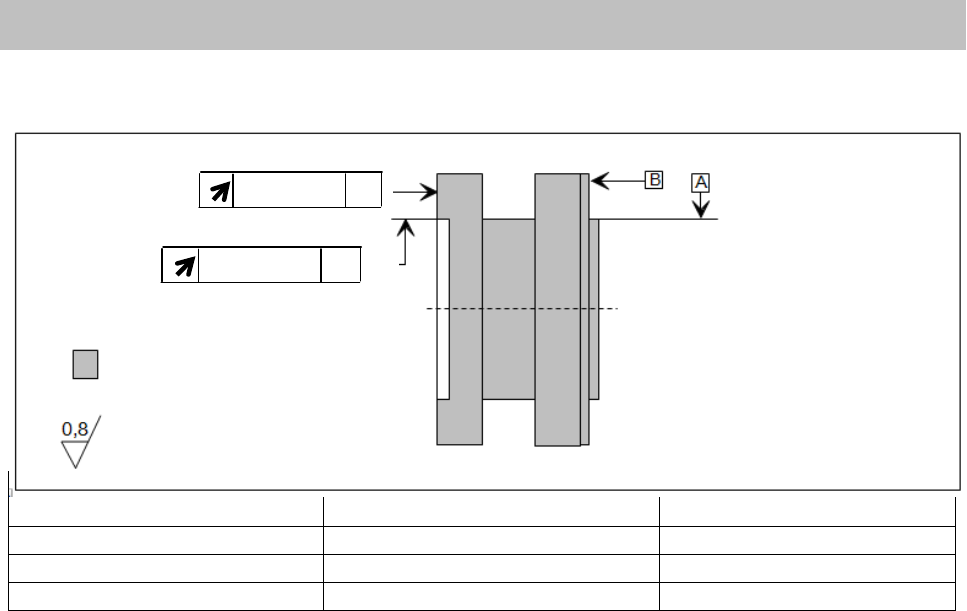
40
15 Supplementary technical information
To ensure that the torque flange retains its characteristics once it is installed, we
recommend that the customer also chooses the specified form and position tolerances,
surface quality and hardness for the connections provided.
Measuring range (kN·m)
Axial run-out tolerance (mm)
Radial run-out tolerance
(mm)
15
0,02
0,02
25
0,02
0,02
Axial and radial run-out tolerances
Axial and radial run-out tolerances
Axial run-out AB
radial run-out AB
Inner centering
Hardness 46 … 54 HRC
Surface quality of axial and radial
run-out surfaces (a, B and AB)
Version b 13.01.2015 HBM: public

41
© Hottinger Baldwin Messtechnik GmbH.
All rights reserved.
All details describe our products in general form only.
They are not to be understood as express warranty and do
not constitute any liability whatsoever.
Änderungen vorbehalten.
Alle Angaben beschreiben unsere Produkte in allgemeiner
Form. Sie stellen keine Beschaffenheits- oder
Haltbarkeits-
garantie im Sinne des §443 BGB dar und begründen keine
Haftung.
Hottinger Baldwin Messtechnik GmbH
Im Tiefen See 45 • 64293 Darmstadt • Germany
Tel. +49 6151 803-0 • Fax: +49 6151
803-9100
Email: info@hbm.com • www.hbm.com
Version b 13.01.2015 HBM: public